Report

Executive Summary
This ninth annual Global Diamond report, prepared by the Antwerp World Diamond Centre and Bain & Company, examines the factors that influenced rough diamond production and sales, midstream performance and the global demand for diamond jewelry in 2019. We also look at the industry’s performance over the past 50 years, analyze historic downturns and apply that history to recent events. Finally, our supply-demand projections through 2030 account for changes to mining operations, macroeconomic factors and the potential impact of lab-grown diamonds.
Note to readers
Welcome to the ninth annual report on the global diamond industry, prepared by the Antwerp World Diamond Centre (AWDC) and Bain & Company. This year’s edition covers industry performance in 2018 and the first half of 2019 and explains key trends that are shaping the industry.
The report begins with key developments along the value chain. In subsequent sections, we review factors that influenced rough diamond production and sales, midstream performance and global diamond jewelry demand in major markets. This year, we also review the industry’s performance over the past 50 years, analyze historic downturns and apply that history to recent events.
We updated our long-term outlook for the diamond industry through 2030. The 2030 supply–demand forecast considers announced production plans, recent changes in mining operations, potential additional sources of supply, expected changes in global and regional macroeconomic parameters, and potential impacts from lab-grown diamonds.
At a Glance:
- Short-term challenges caused mining and midstream revenues to shrink by 25% and 10%, respectively, in 2019. Near record-high rough diamond production in the beginning of 2019 was followed by lower-than-expected demand for polished diamonds, causing a ripple effect through the supply chain. The softer demand for polished diamonds was driven by two major factors: geopolitical and macroeconomic tension lowered consumer confidence and thus demand, and an increase in e-commerce created efficiencies in the supply chain that decreased the need for inventory on hand.
- Available financing for midstream players decreased by $5 billion since 2013. This 30% decline in financing impacted the ability of manufacturers to support the growth of their operations. Traditional diamond banks curtailed their exposure to the diamond sector. Indian banks adopted a more conservative approach following the poor performance and challenges of the Indian financial sector at large. Cutters and polishers reduced rough diamond purchases about 30% to off-load inventory and improve their cash flow. In 2019, access to affordable financing became even more challenging for midstream players.
- In 2019, global diamond jewelry retail sales are expected to decline by up to 2% in US dollars based on the retail performance during the first three quarters of the year. In local currency, we expect the demand for diamond jewelry to remain stable. The strength of the holiday shopping season will determine the final outcome. The decline is driven by changes in the two largest markets, the US and China, where jewelry sales are expected to decline by 2% and 5%, respectively, in 2019. However, the holiday season may reverse that trend. In the US, the downturn is attributed to three things: shrinking consumer confidence, a decline in Chinese tourists that consequently lowered luxury purchasing, and a 15% tariff on Chinese jewelry that went into effect in September. Despite a shift toward local consumption, the diamond jewelry market in Greater China is also expected to decline.
- Softer demand for polished diamonds led to a 3% drop in polished prices and is expected to lead to 10% to 15% lower revenues for midstream players. The slowdown resulted in some of the lowest profit margins experienced in years, as well as high inventory levels, which have been accumulating since 2017.
- Rough diamond sales are expected to fall by 25% in 2019 though rough diamond production remained stable. Major rough diamond producers responded to midstream pressure by increasing their inventory levels and offering more flexible purchasing terms, cutting rough diamond prices by 5%. Junior miners lowered prices by 7% to 10% in attempts to minimize inventory.
- Based on historic experience, the market typically returns to precrisis levels within one to two years. Aside from the current downturn, the diamond market has faced only four recessions in the past 50 years. In the same time frame, rough diamond production has grown three times, and rough and polished prices have increased 450% and 250%, respectively.
- We expect the midstream to clear its inventory backlog in the beginning of 2020, bringing a better year for the industry. However, based on our historical analysis, the industry is not likely to fully recover in 2020 because of ongoing supply–demand inequality and limited growth of financing options for midstream players. Major diamond producers have not announced substantial mining plan cuts, and we do not expect significant retail growth in 2020, as consumers brace for a global recession. The industry will have a stronger chance to rebalance and grow in 2021.
Four key trends are currently shaping the diamond industry:
- The rapid growth of e-commerce in the diamond jewelry market lowered polished sales performance in 2019 and will continue to influence the diamond pipeline. Online sales and more efficient supply chain operations require less inventory on hand, causing a need to rethink the business model for midstream players.
- Marketing spending is increasing to address complex consumer needs. Customer preferences are changing rapidly, and the diamond jewelry industry is facing increased competition from the Experiences and Electronics categories and from lab-grown stones.
- The lab-grown diamond market grew 15% to 20% again in 2019. Chinese and Indian producers drove the increase, aided by the widening price differential of lab-grown diamonds versus natural ones and campaigns that leveraged the “green” benefits of manufactured stones. Select jewelry designers and retailers are beginning to use lab-grown diamonds, signaling their acceptance and driving lab-grown jewelry sales.
- The focus on sustainability and social welfare is heightened. Both consumers and the professional community are seeking transparency throughout the pipeline to ensure diamonds are sourced responsibly and produced sustainably. Blockchain solutions are being used to track diamond origin, and programs are emerging to minimize negative environmental impacts and to support people in remote locations with employment opportunities.
The long-term outlook for the diamond market remains positive despite short-term challenges. In volume terms, rough diamond supply growth is projected to be negative 2% or 0% annually. Demand for mined rough diamonds is expected to recover, either staying flat or growing up to 3% annually through 2030. Recovery requires continued growth of GDP, the middle class and purchasing power, particularly in China and India. To convert increased wealth into growth, the industry must also provide structured marketing support. Both industry-wide and company-specific marketing are necessary to revive and sustain demand. In the conservative scenario, our projection accounts for a possible shift in consumer preferences away from natural diamonds due to lack of marketing support. It also reflects fundamental long-term supply and demand factors rather than short-term fluctuations.
1. Recent developments in the diamond industry
- The diamond industry experienced short-term challenges in 2019, particularly compared with 2018, in which every segment of the value chain improved. In 2019, rough diamond producers achieved near record-high production while jewelry retailers optimized and lowered their inventory needs. As a result, we expect mining and midstream revenues to decrease by 25% and 10%, respectively, in 2019 and diamond jewelry sales to be nearly stable in local currencies.
- In the second half of 2018, demand for rough diamonds began to stall, causing inventories to rise and prices to decrease. In 2019, rough diamond revenue is expected to decline 25%. In response, major mining companies are adjusting production plans for 2019, cutting their minimum purchase requirements in half and lowering rough diamond prices by about 5%. Smaller players are dropping prices more significantly (as much as 10%), and many smaller producers skipped planned auctions in the third and fourth quarters.
- After modest growth in 2018, cutting and polishing revenues are expected to decline 10% to 15% in 2019. The surge in production, combined with more sophisticated inventory management by retailers, puts pressure on revenue and margins in the midstream. Many cutting and polishing manufacturers are reporting operating margins at or below their breakeven points. To maintain factory utilization, midstream players purchased more small stones, which increased demand for smaller rough diamonds.
- Retail demand has been mixed over the past year and a half. In 2018, robust diamond jewelry sales resulted in 2%growth. But in 2019, retail sales are expected to decline by up to 2% in US dollars and remain stable in local currencies. This is a result of the trade tension between the US and China and deteriorating consumer confidence overall. In the US, a slowdown in Chinese tourism also negatively affected sales. Weakened currencies in most major non-US markets hurt retailers’ performance. Like never before, everyone is closely watching this holiday season, which will determine retail’s final annual results.
- The short-term situation remains uncertain: rough diamond production is still relatively high, whereas geopolitical and economic uncertainties loom over every key market.
- Learning from past diamond industry recessions, we foresee a resolution in the next two years. If the industry is appropriately supported by marketing, and barring any unforeseen economic or political shocks, it will rebalance. Campaigns should target the mass market, which is not traditionally covered by branded advertisers.
Bargaining power varies across the diamond value chain

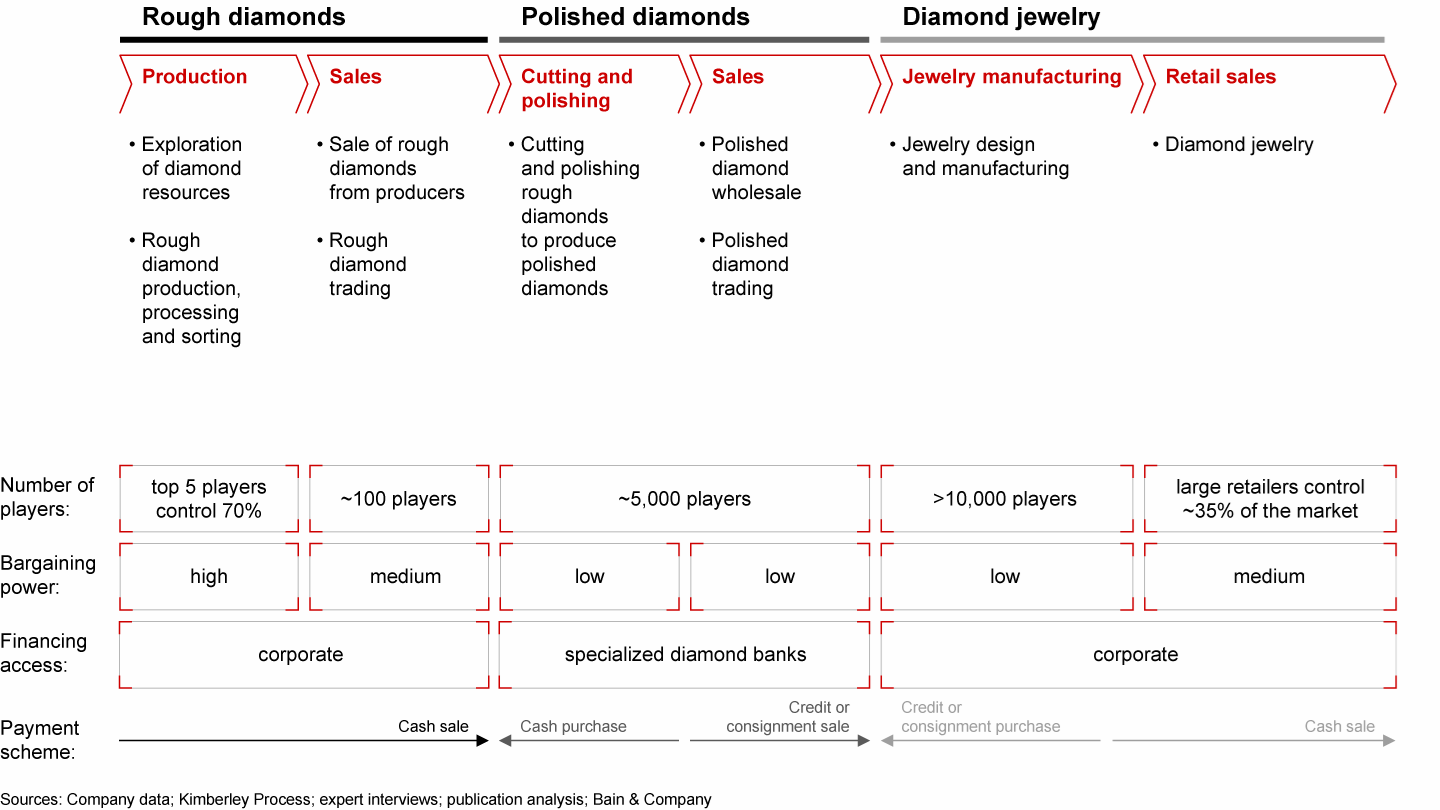
Revenues across the value chain trended downward in 2019

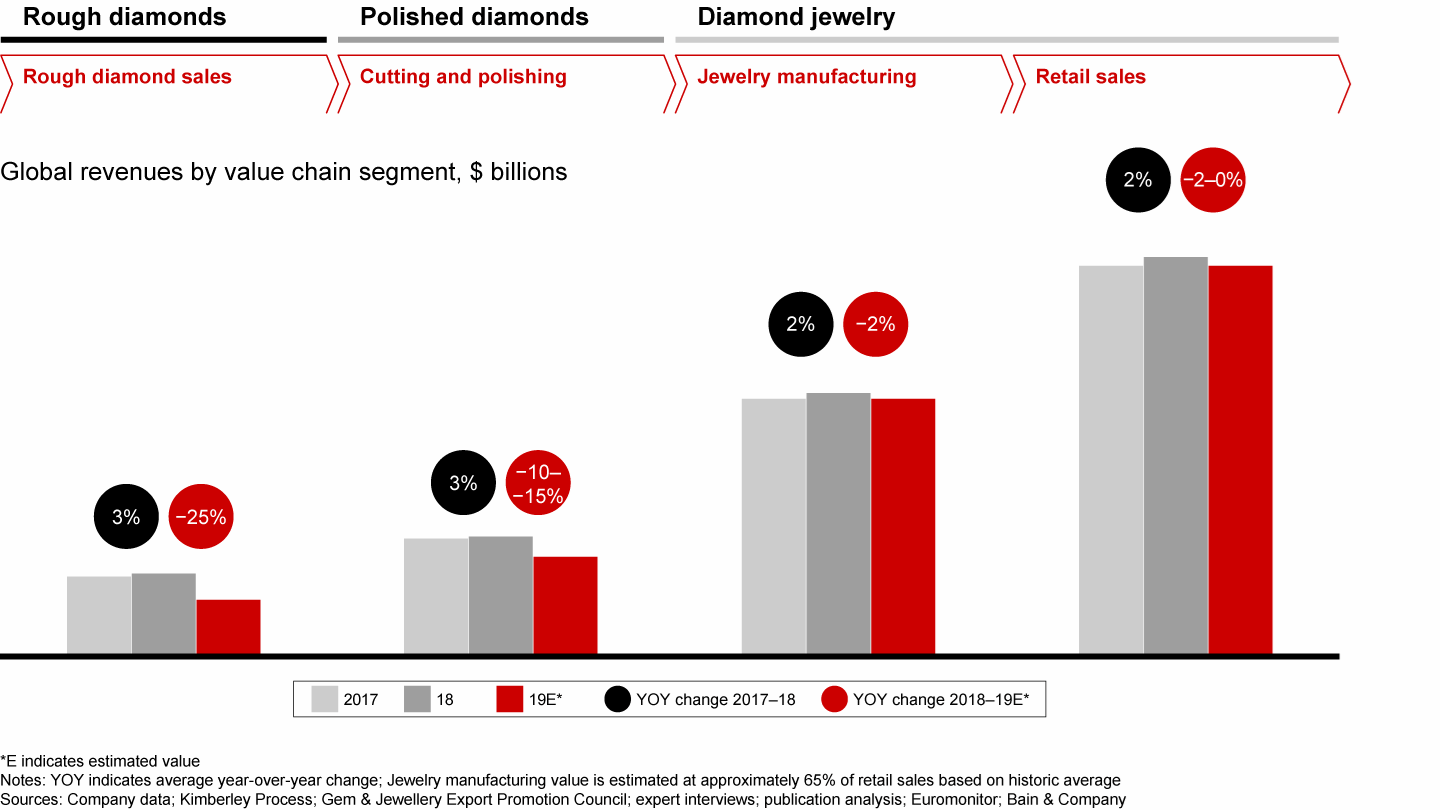
Rough diamond sales are expected to decline 25%

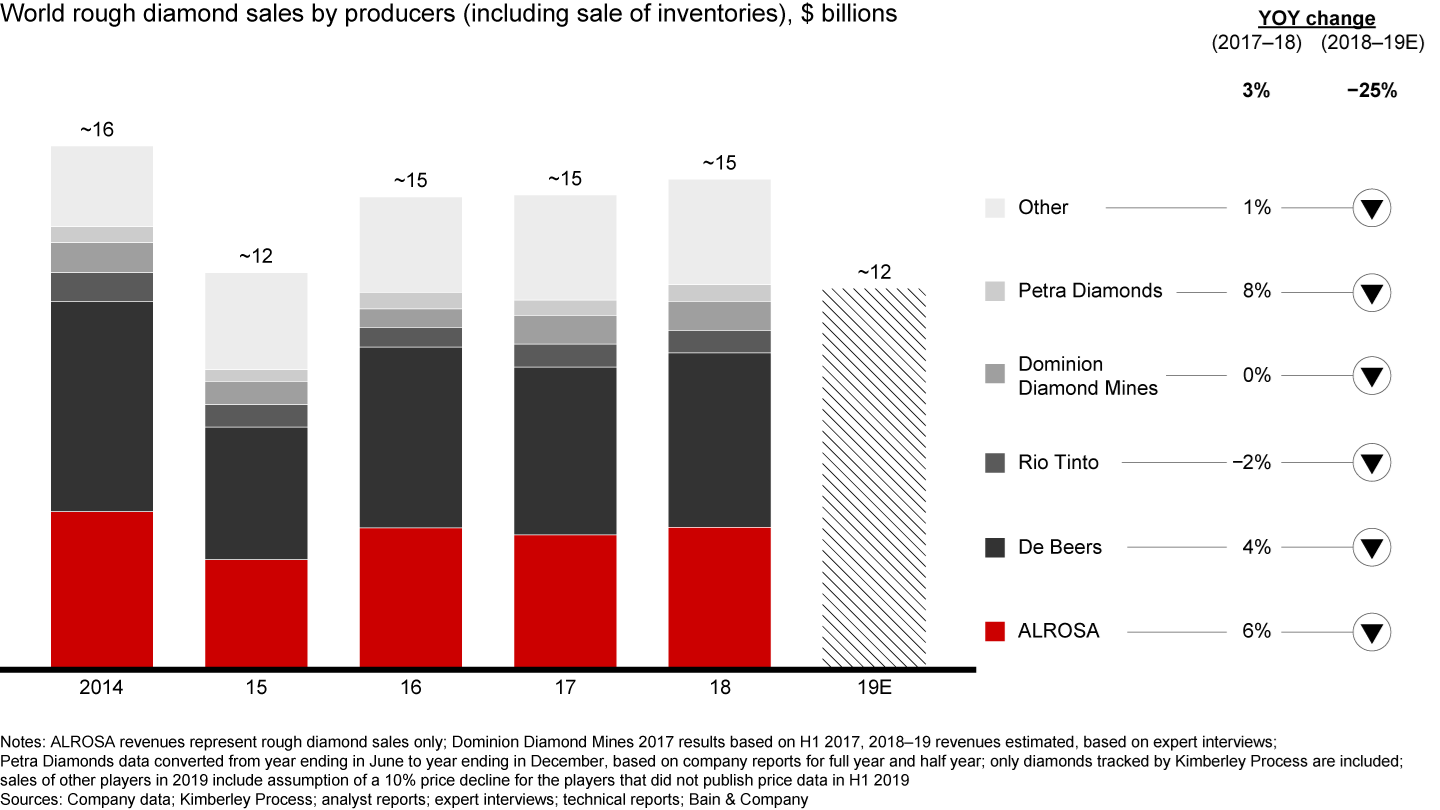
Rough and polished prices and trading volume both declined in 2019

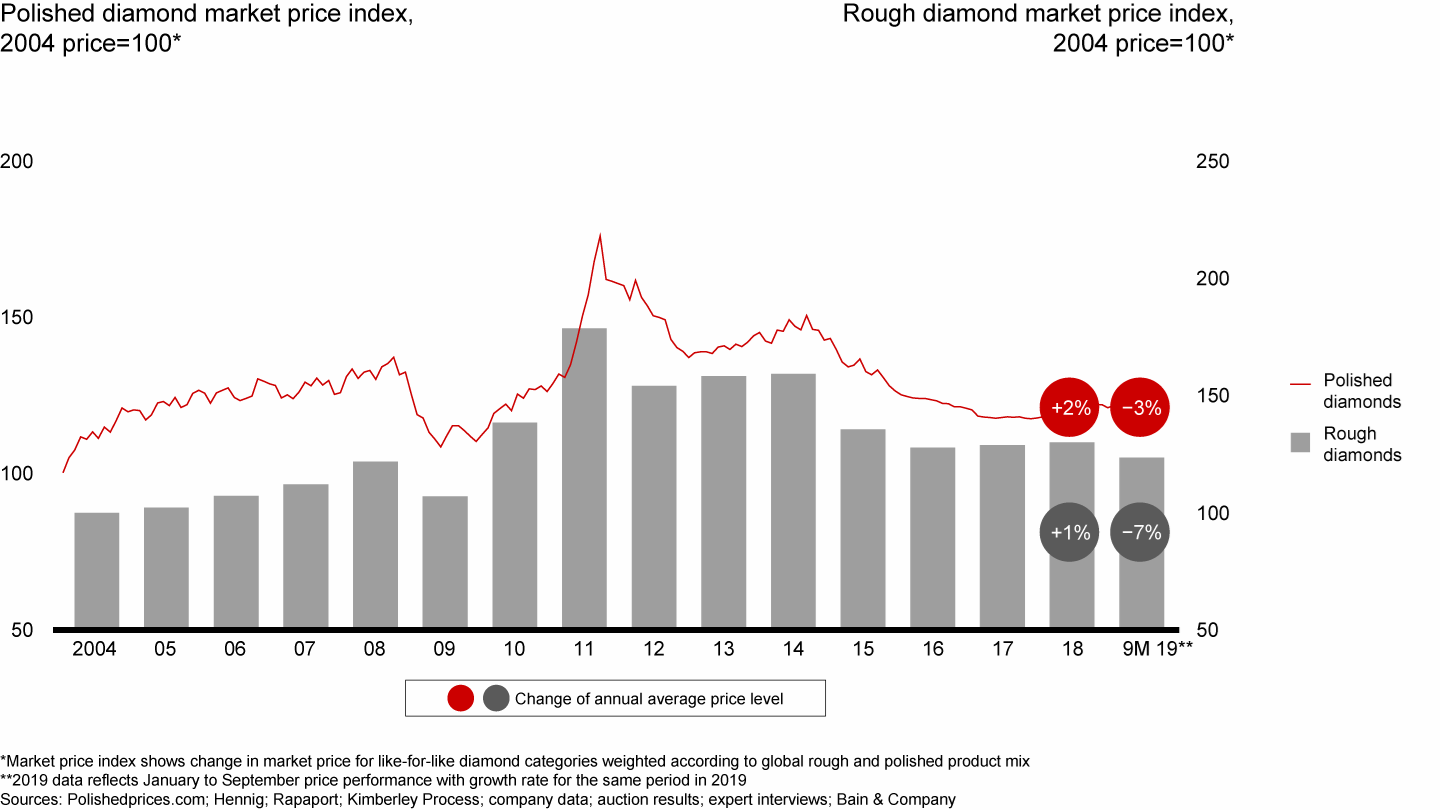
Midstream inventories grew in 2018 but are expected to decrease in 2019

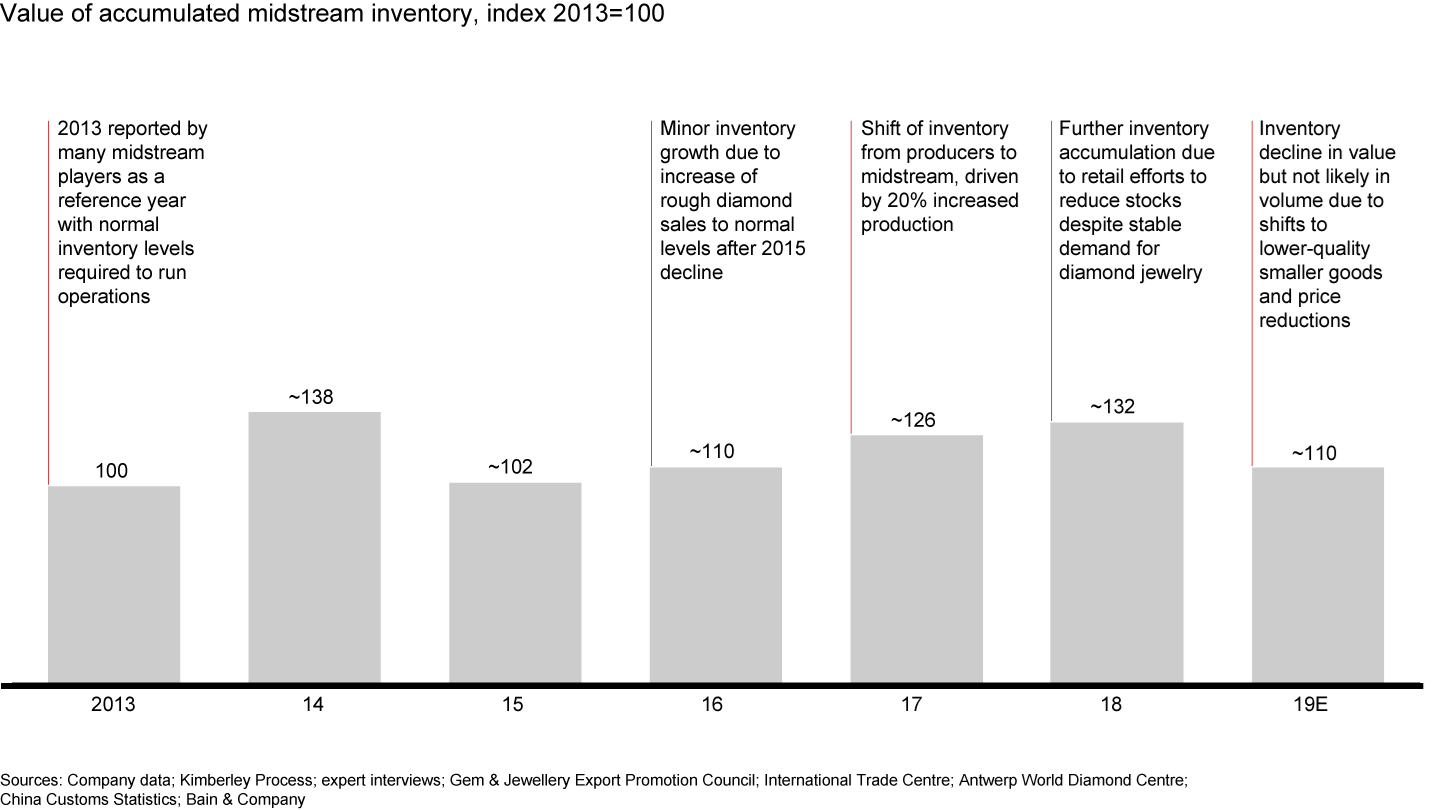
Profit declined across the value chain in 2019

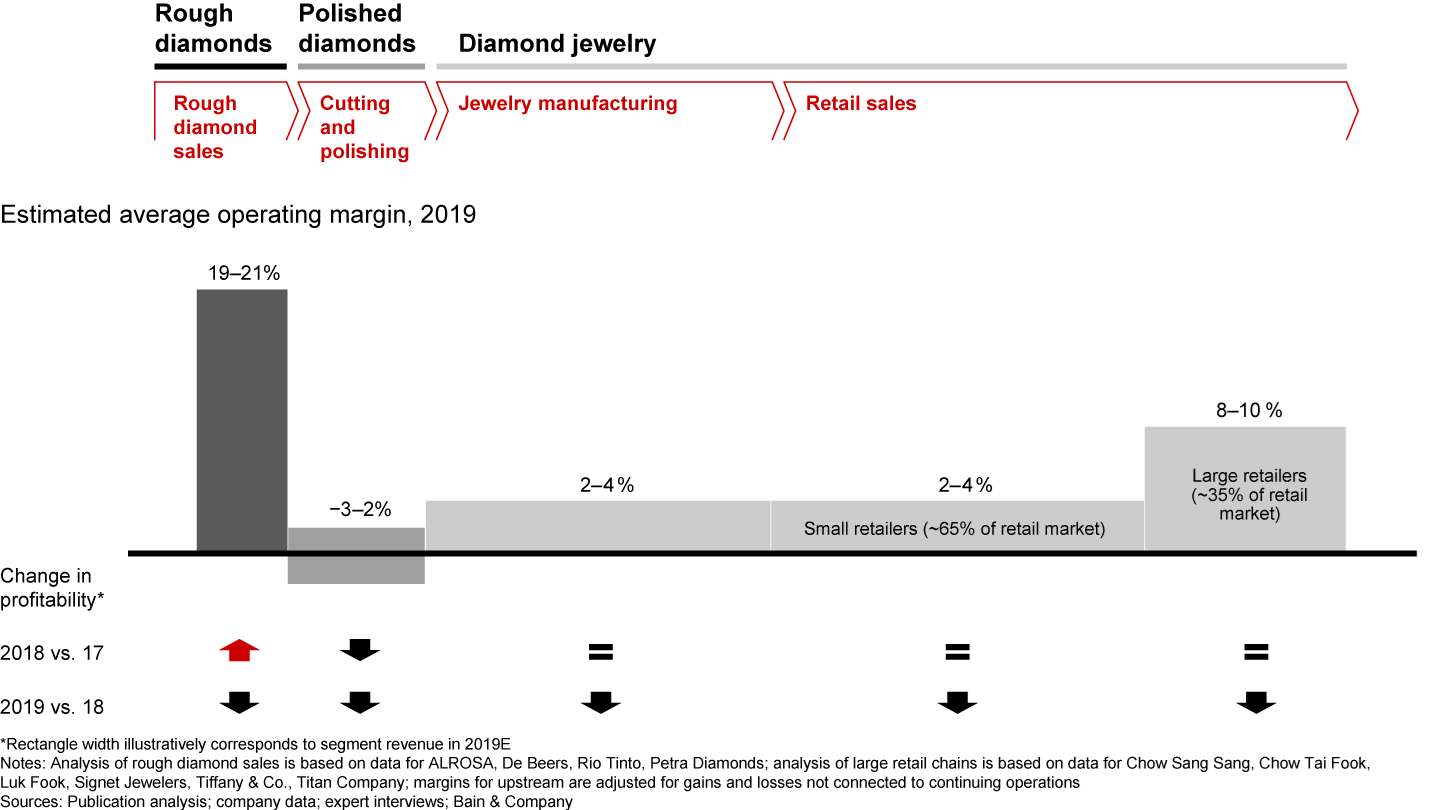
2. Rough diamond production
- Between 2010 and 2016, global production was consistently between 120 million and 130 million carats. In 2017, it jumped to roughly 152 million carats and then fell 3% to 147 million carats the following year. The decrease in 2018 is largely attributed to lower production in Australia, the Democratic Republic of the Congo and Russia. The unexpected closure of Mir in Russia and planned downscaling at Argyle in Australia contributed to the decline.
- The 26 million-carat production increase in 2017 was the largest single-year volume increase since 1986, and it created a surplus that affected the entire value chain. As a result, inventory in the mining and midstream markets increased through 2019. Prices and revenues declined in both segments in 2019 despite only a slight decrease in consumer demand. Assortment sales shifted toward smaller stones in 2019, which also contributed to lower sales.
- In 2019, production is expected to drop an additional 4%. Production is depleting at Argyle in Australia; in South Africa, Venetia is transitioning from open pit mining to underground; and production levels were lowered at Orapa in Botswana. These changes will be partially offset by increased supply from several ALROSA mines in Russia and smaller players in Angola.
- During the first half of 2019, pressure on rough diamond prices, sales mix and sales volume led to lower adjusted EBIT (earnings before interest and taxes) margins for most producers. ALROSA maintained the highest margin in the rough diamond production segment. Rio Tinto and several other junior miners with high shares of small-gem- and near-gem-quality diamonds reported negative EBIT margins in the first half of 2019.
- We expect the supply of natural diamonds to decline substantially starting in 2021, with an annual decrease of 8% compared with 2020 projections. The downward trend from the past few years will be amplified by supply contraction at Argyle and at Diavik and Ekati in Canada.
Production is expected to decline by 4% in 2019

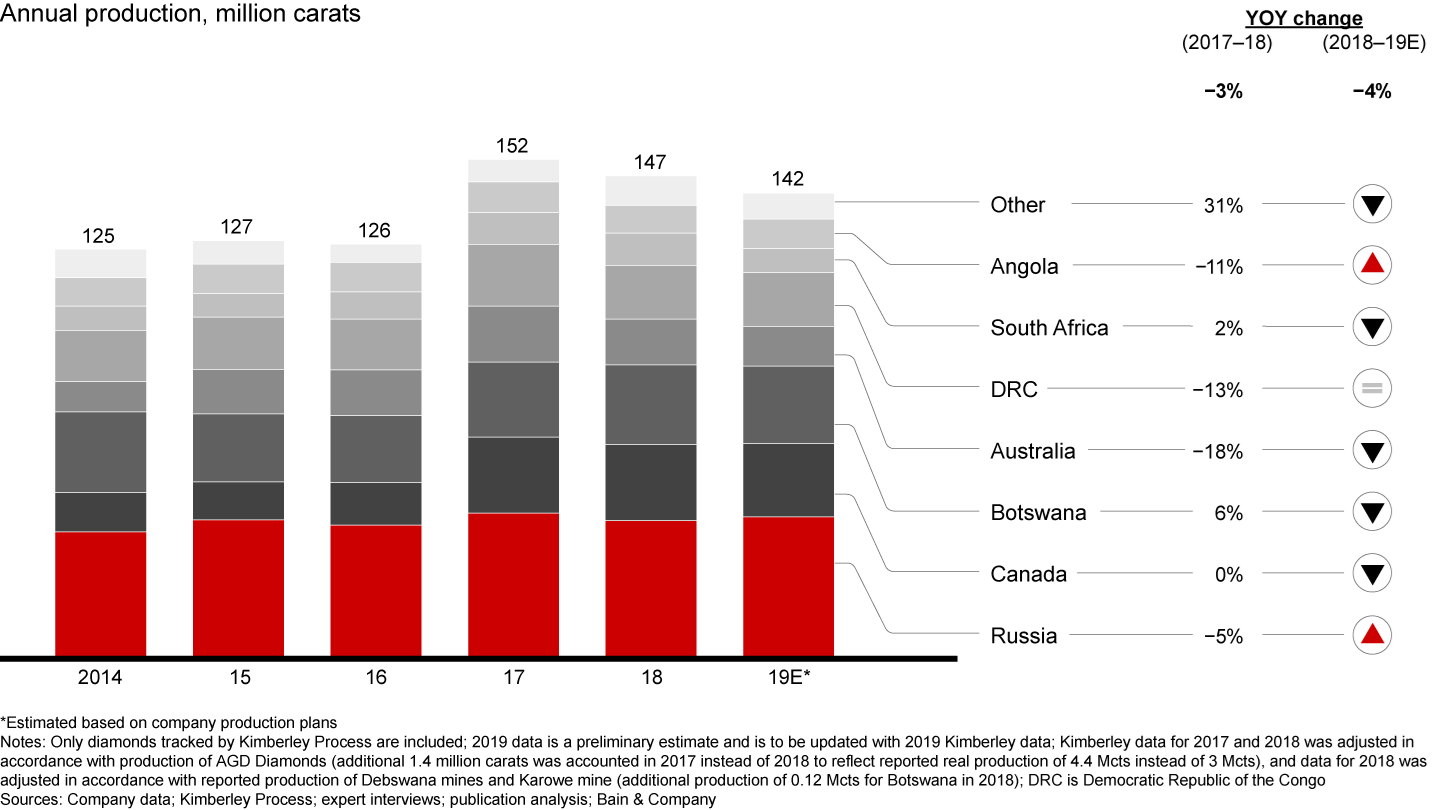
Most diamond producers lowered guidance for 2019

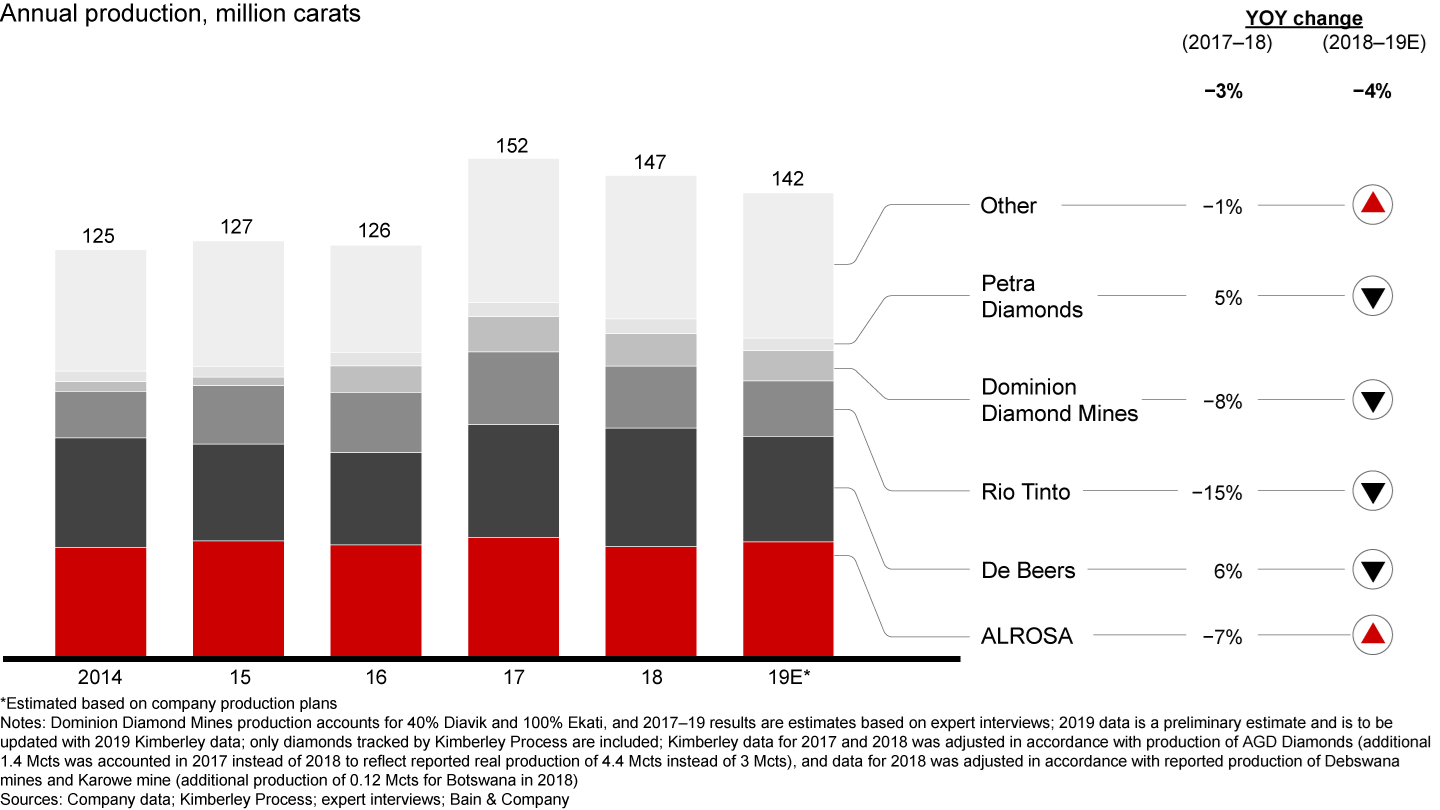
Australia, South Africa and Botswana experienced the most decrease in production in 2019

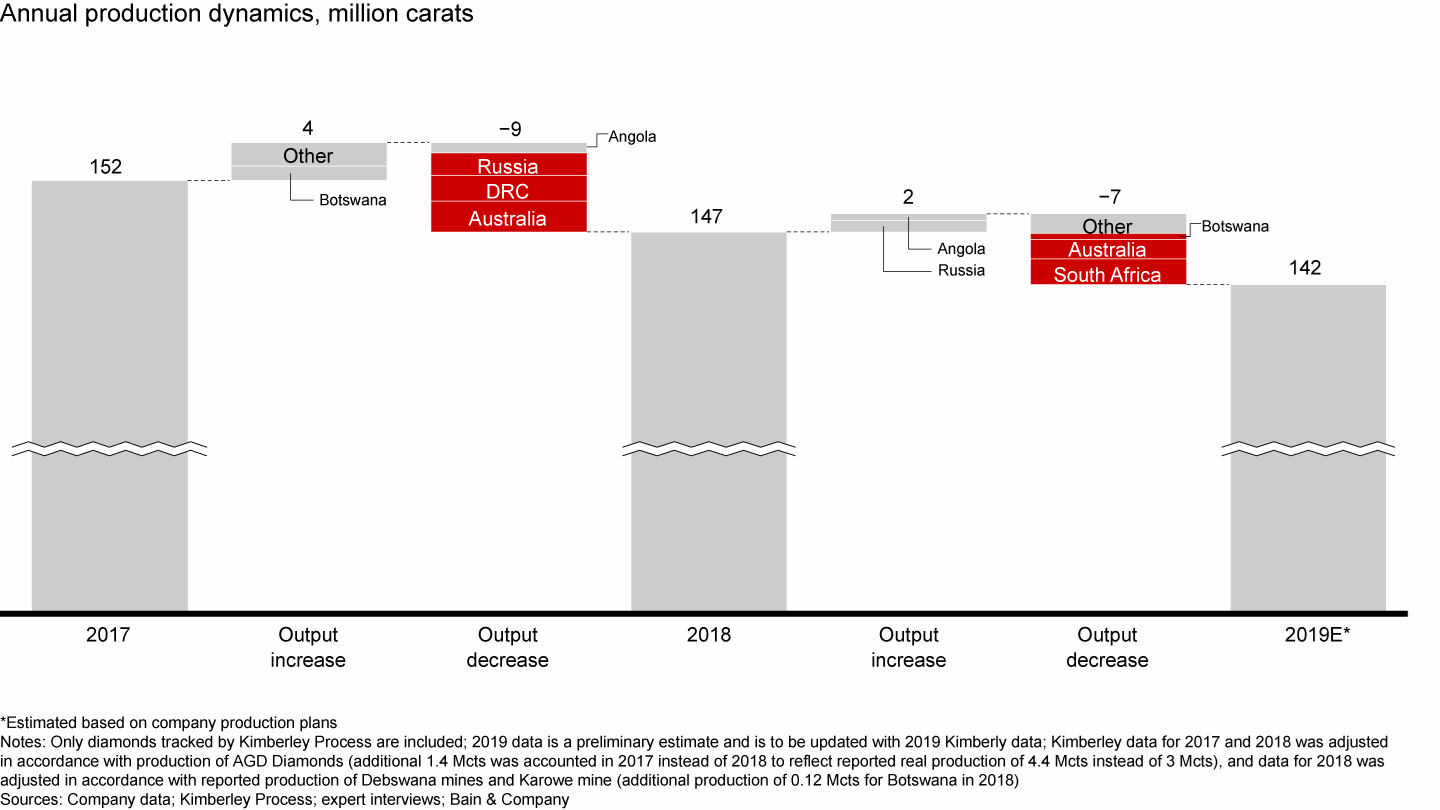
Annual production increased by 16 million carats over the past three years

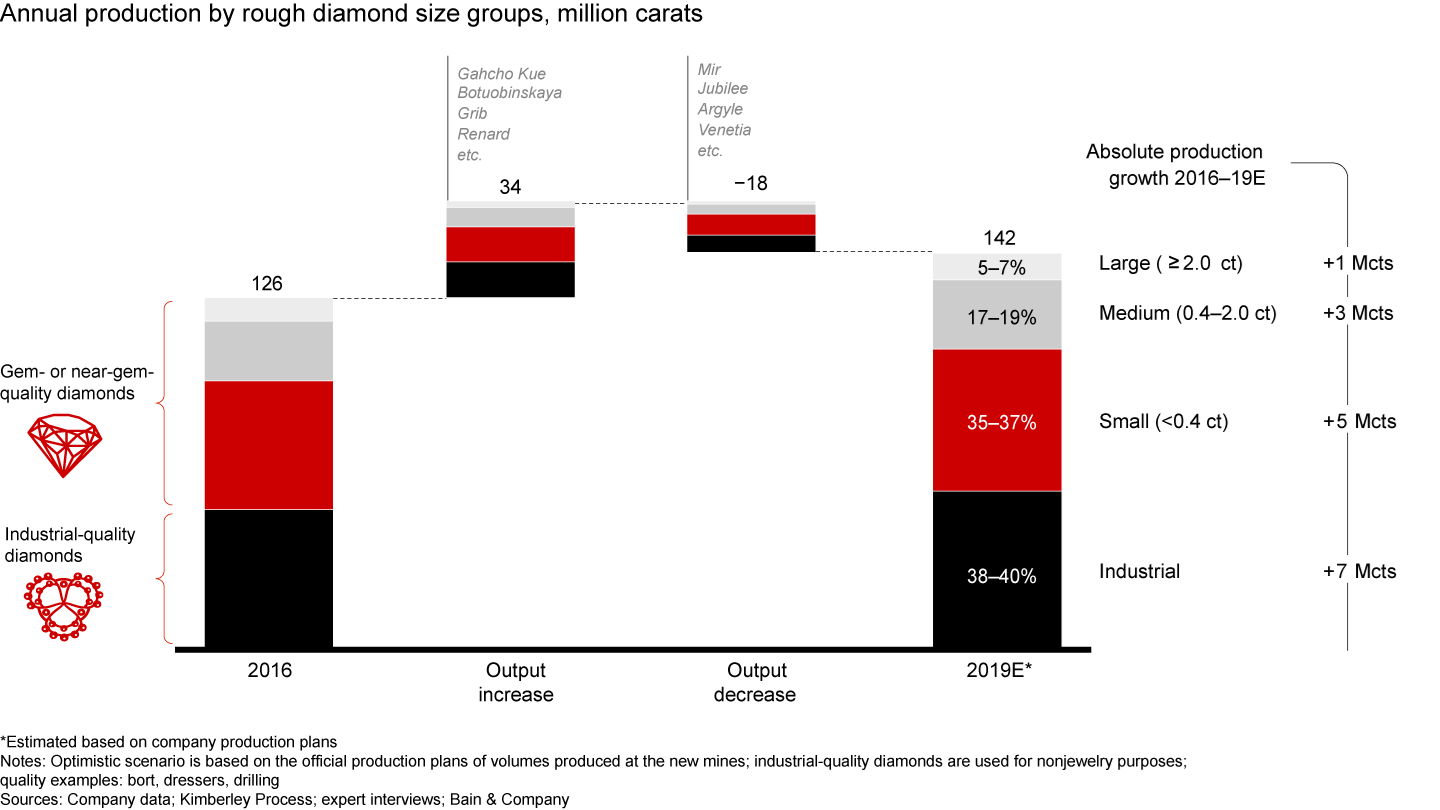
Diamond producer margins showed mostly positive dynamics in 2018—but not in 2019

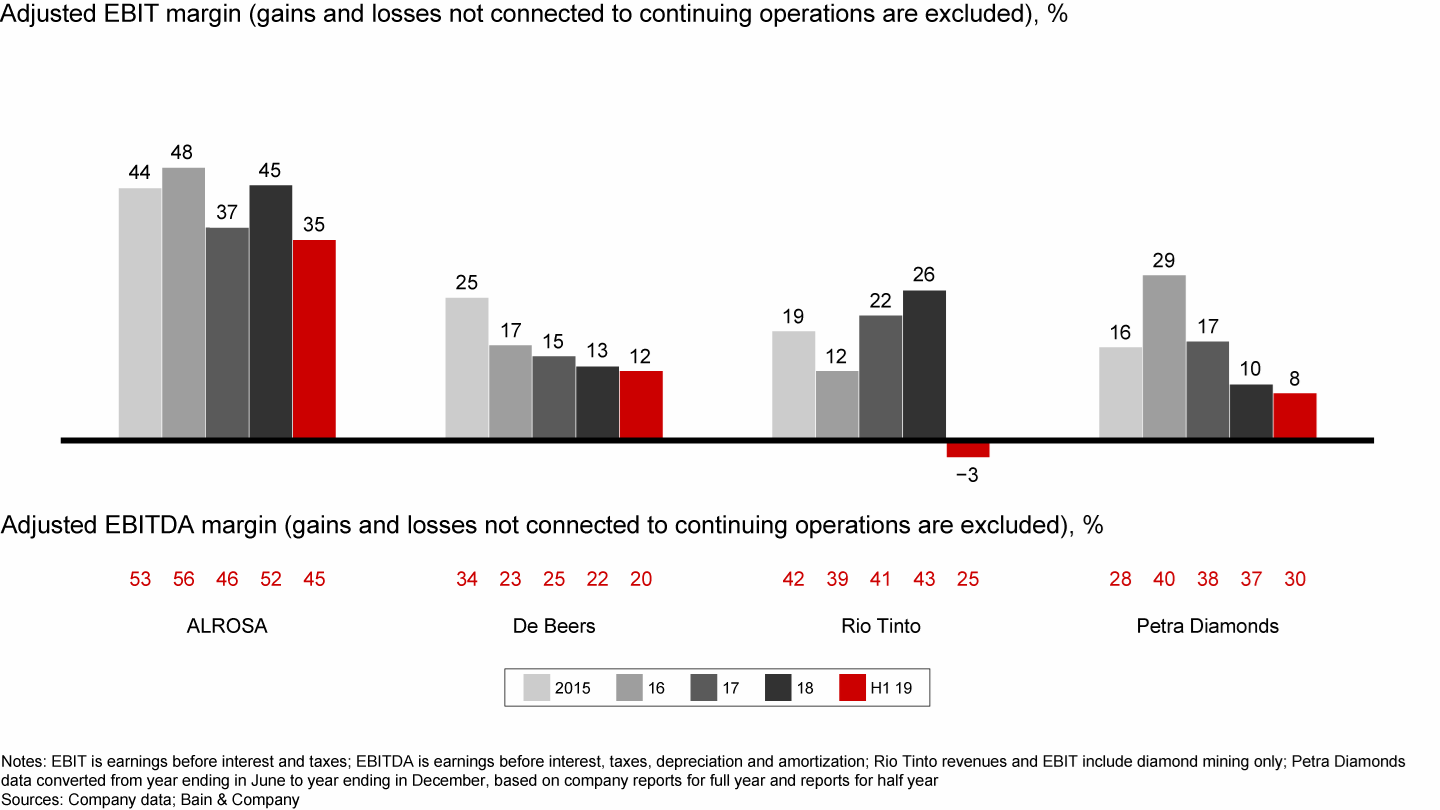
Production could decrease to 2016 levels in three years, with the greatest reductions in small and industrial diamonds

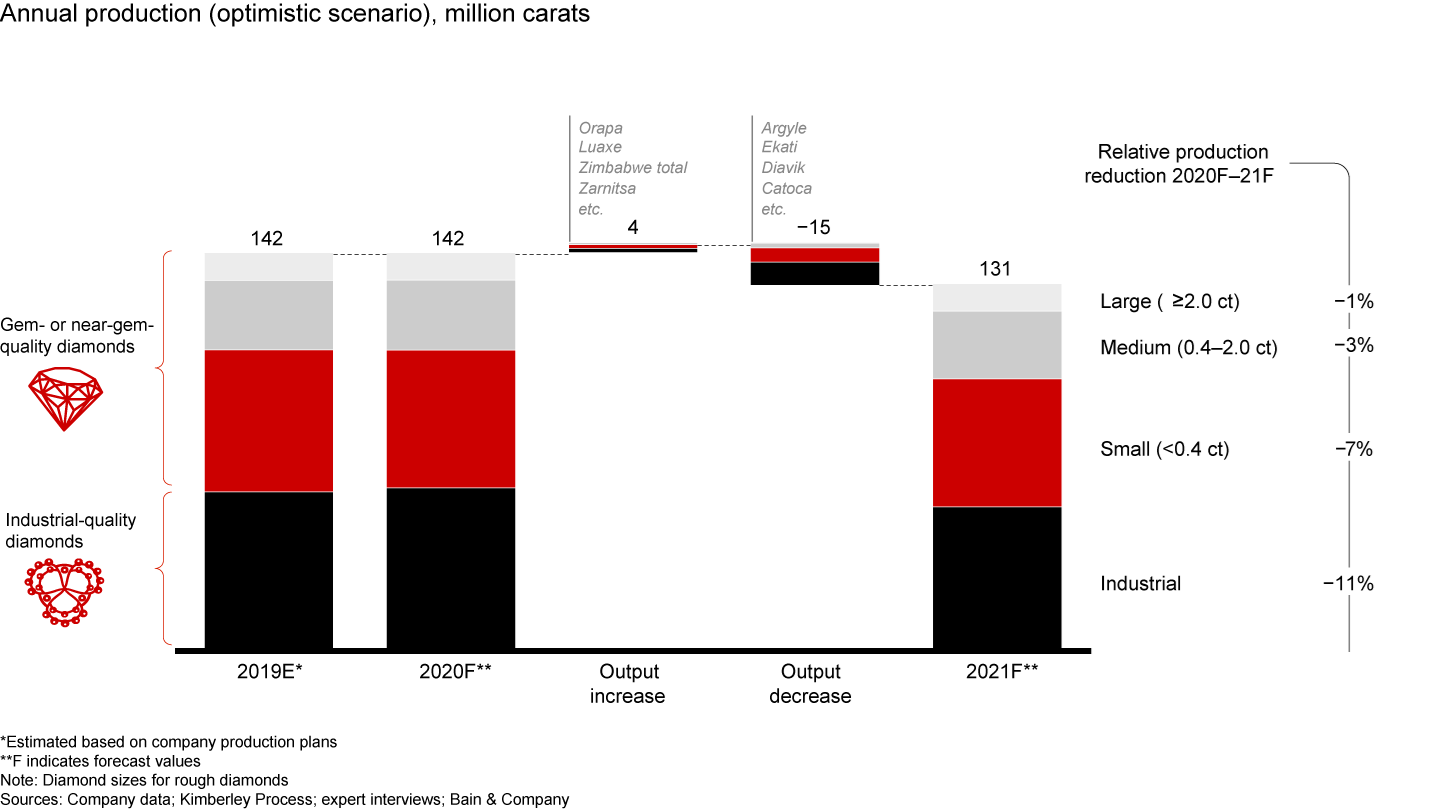
3. Cutting and polishing
- In 2018, cutting and polishing revenue grew 3%, supported by a healthy increase in consumer demand for diamond jewelry. However, polished diamond sales are expected to drop 10% to 15% by the end of 2019 because of slowing demand for diamond jewelry globally, lower diamond content in jewelry designs, inventory optimization by major retailers and declining available financing for midstream players.
- The combination of lower polished diamond sales and excess inventory accumulated by the midstream in 2017 and 2018 reduced net imports by 3% and 30% in 2018 and 2019, respectively. India experienced the steepest decline. In India, weakened local currency, liquidity issues resulting from bank financing cuts, and ongoing effects of demonetization contributed to stockpiling of incoming goods.
- Slower sales and stretched working capital damaged the sector’s profitability. On average, operating margins in the cutting and polishing segment contracted 2% to 3% in 2019 compared with 2018. To sustain profitability, the midstream companies cut excess capacity and shifted their focus to melee diamond production to maintain factory utilization and minimize working capital. The decline of rough diamond prices exacerbated the situation, leading to stock devaluation and, in some cases, affecting financing options. In the midterm, the segment will continue to operate with significant pressure on the bottom line.
- Interest rates, maturity and availability of financing continued to challenge the midstream segment in 2019. Interest rates increased to match rising default risk. In 2019, cutting and polishing players needed longer-maturity loans for two reasons: growth in consignment practices increased the number of days for receivables to turn over, and inventory turnover days increased because of lower demand among certain assortment groups. Traditional diamond banks tightened financing and credit requirements, and key Indian banks became more conservative following the generally poor performance of the Indian financial sector. The current situation presents an opportunity for nontraditional financing options, which are currently limited to a handful of large midstream players.
- Short-term pressure on the midstream could lead to long-overdue restructuring and consolidation within the segment. Even in the current situation, some companies are making money. Successful players have shifted from a supply-driven mindset to a demand-driven model in which they make purchasing decisions in line with downstream demand. These companies also offer greater transparency, which is attractive to financing institutions and banks.
India continued to dominate the cutting and polishing industry

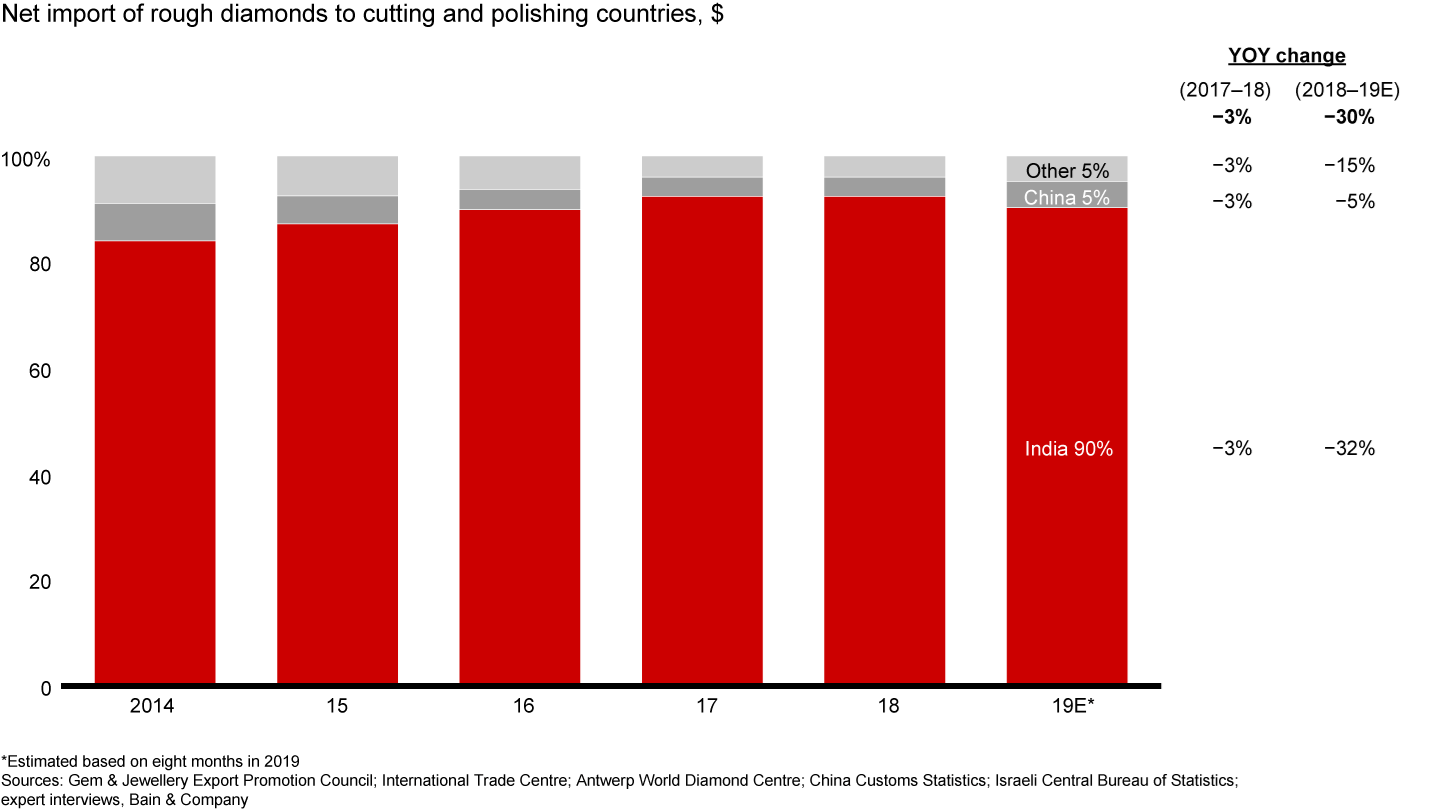
In India, net imports of rough diamonds decreased 3% in 2018 and 32% in the first eight months of 2019

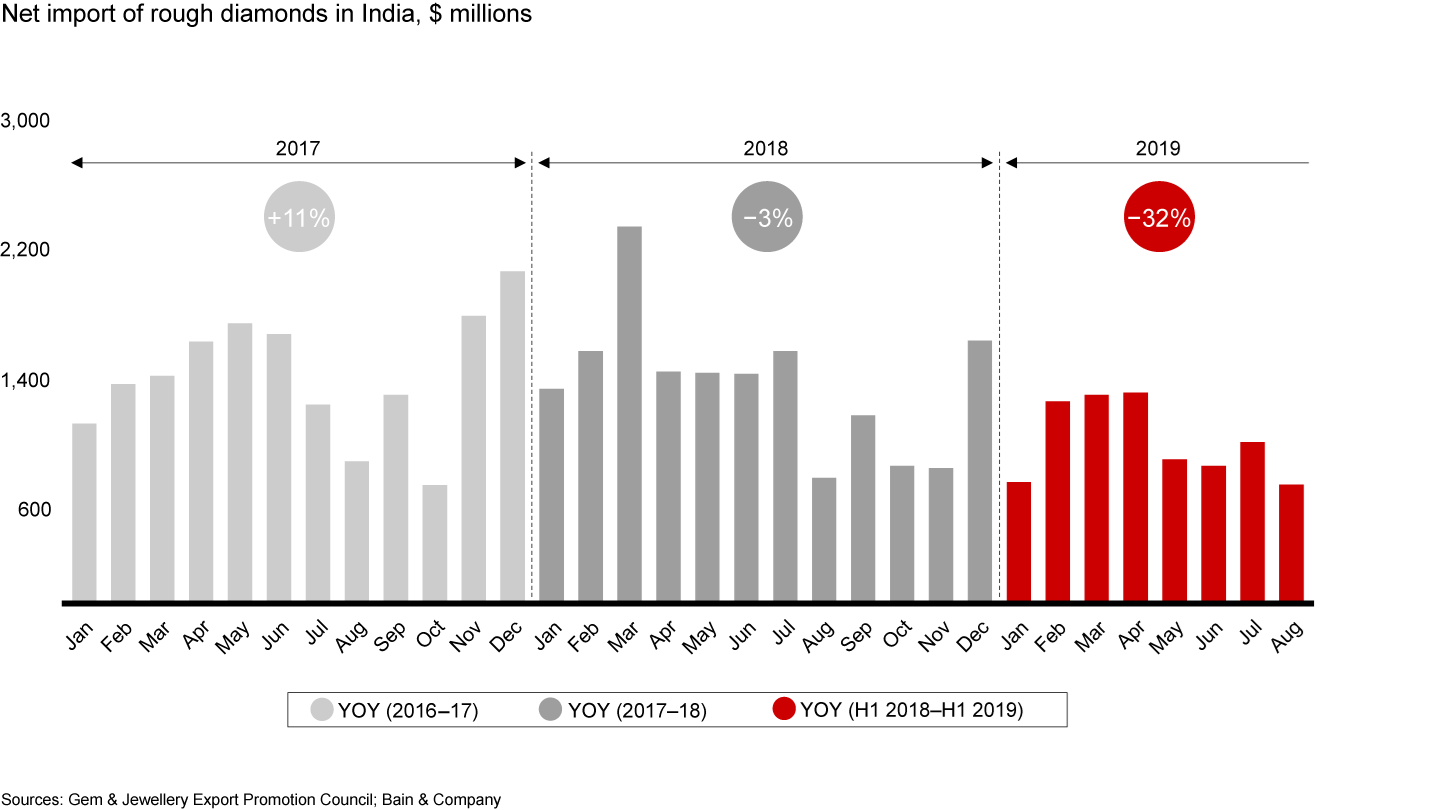
Cutting and polishing profit margins were stable in 2018 but are expected to decrease in 2019

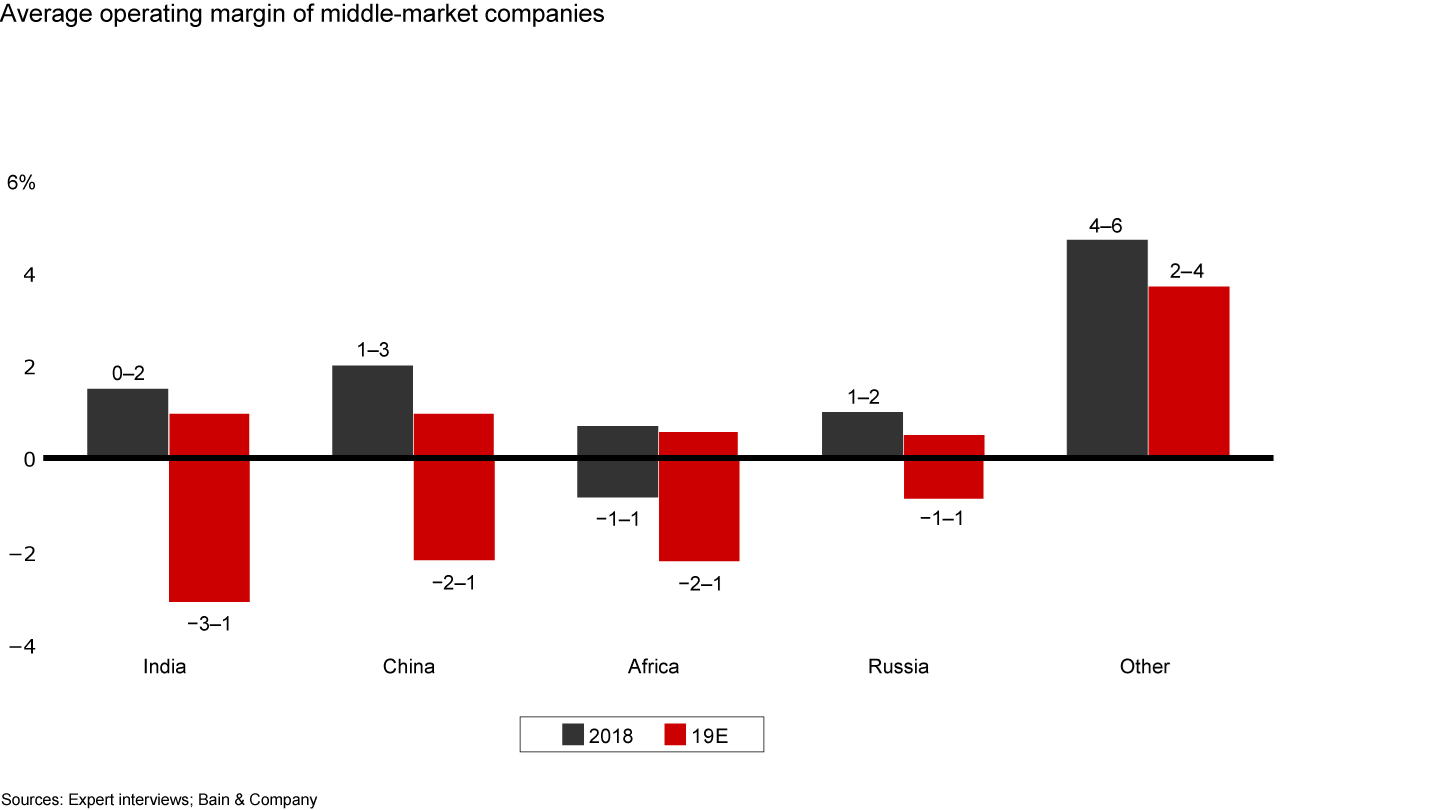
Average cash conversion is 235 to 300 days in the midstream, which explains the need for financing

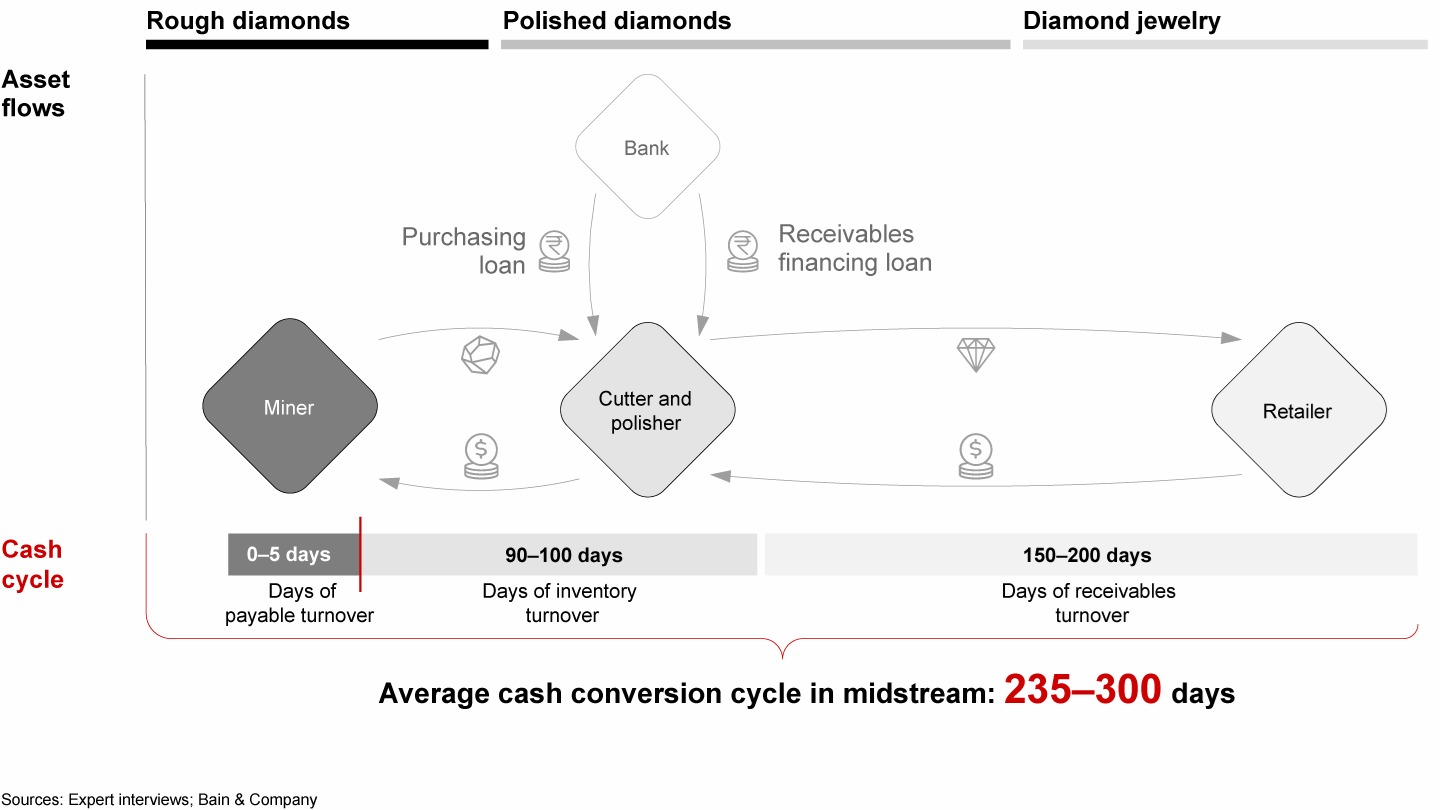
Outstanding debt in the midstream is expected to reach $11 billion in 2019

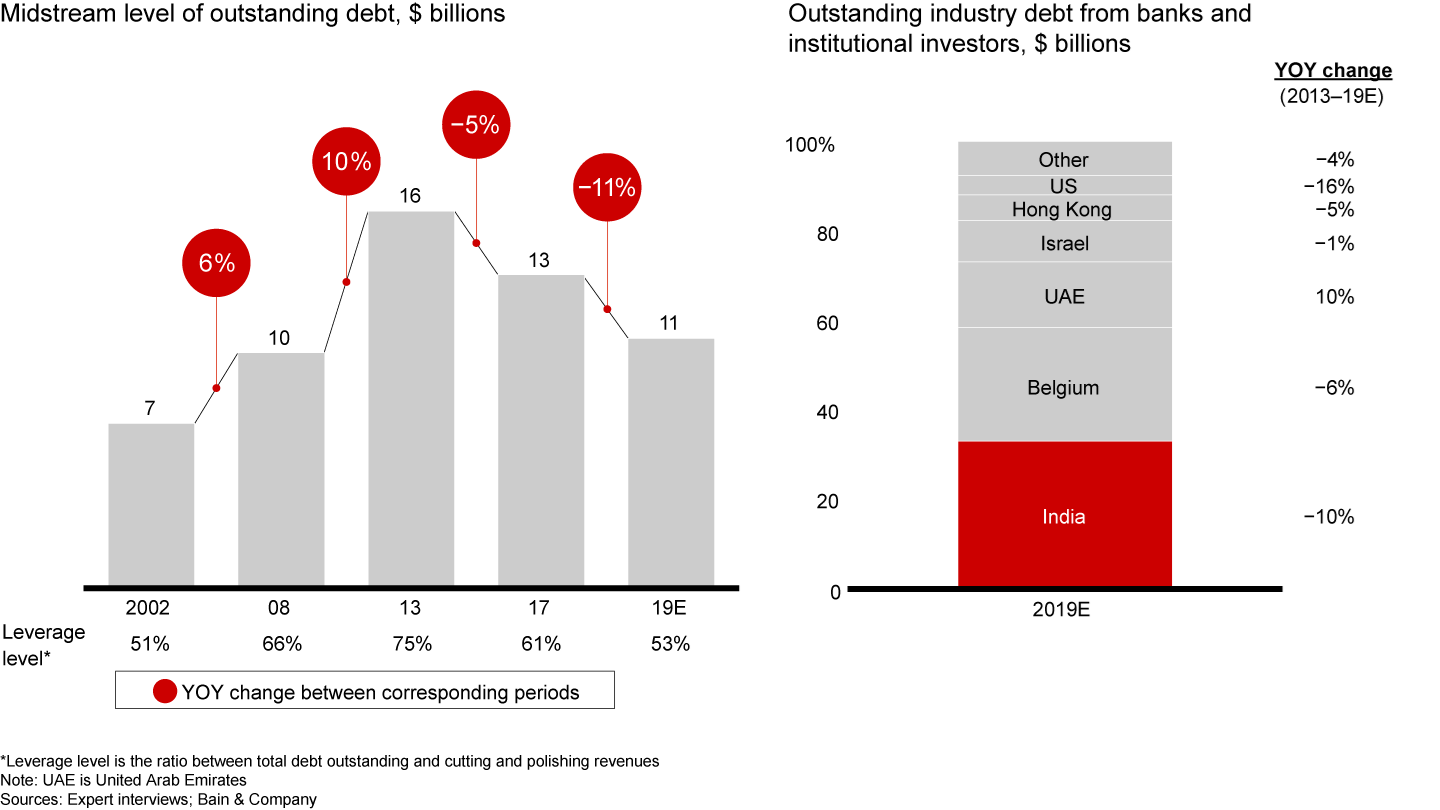
Decreased financing from traditional banks created opportunities for alternative financing


4. Diamond jewelry retail
- The global personal luxury goods market, the bellwether of the diamond jewelry industry, experienced slower growth in 2018 and 2019. The slump was caused by moderating global GDP growth, lower consumer confidence. Global diamond jewelry retail posted 2% sales growth in 2018, but sales are expected to decline by up to 2% in 2019, based on the results of the first three quarters. A strong holiday season could reverse the trend.
- In 2019, US diamond jewelry retail sales are expected to fall 2%, in contrast to 3% growth in 2018. There are three key reasons for the reversal. First, consumer confidence fell to its lowest point since 2016 because of uncertainties surrounding the labor market, trade tension and a possible recession. Second, a continuous decline in Chinese travelers to the US lowered luxury purchases overall. And third, an extra 15%tariff on Chinese jewelry went into effect in September 2019 and could impact sales during the crucial holiday season.
- In 2018, the Chinese market, including Hong Kong, grew 4%. In 2019, that trend reversed; the Chinese market is expected to decrease by 5% in US dollars equivalent and 1% in local currency. The shift is attributed to yuan depreciation, declining consumer confidence stemming from trade tension between the US and China, and significantly lower sales in Hong Kong amid protests in the area. The decrease will be partially offset by growth in local consumption in Mainland China. A repatriation trend is being driven by import duty reductions, stricter gray market control and price harmonization among international retailers.
- The Indian diamond jewelry market declined by 1% in 2018 following rupee depreciation and the bankruptcy of large jewelry retailer Gitanjali in India. In 2019, sales are expected to return to healthy 3% growth due to increased customer confidence, a growing population of working women and
- A shift in preference from occasion-only to everyday jewelry. However, retail sales are being reined in by tighter tax controls for luxury spending, a spike in gold prices and continuing rupee depreciation.
- In 2019, performance in Europe was negatively affected by sociopolitical turmoil in the UK and France, but this was partially offset by higher tourism spending in the Eurozone. Japan is expected to remain stable in 2019 because of lower consumer confidence and decreased spending by Chinese tourists.
- The midterm outlook for 2019–20 remains uncertain given continued geopolitical instability, strong signs of an impending recession and limited marketing support, especially for nonbranded and lower-end jewelry. The branded luxury diamond jewelry segment, which accounts for about 15% of the total diamond jewelry market, is expected to perform well, growing at high single digits. That is in line with the growth of personal luxury goods.
The diamond jewelry market is influenced by personal luxury and mass consumption trends

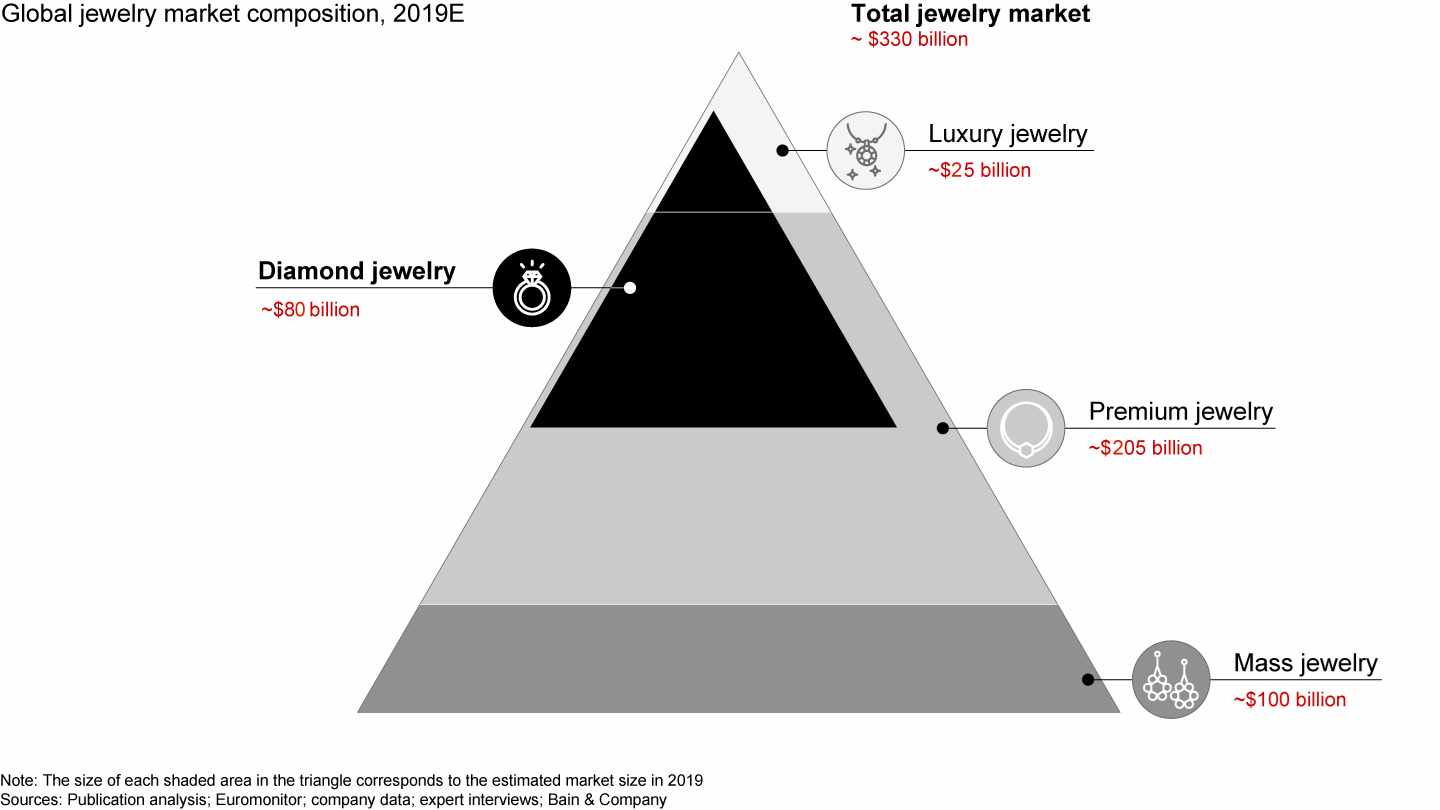
Personal luxury and diamond jewelry spending have largely followed GDP over the past five years

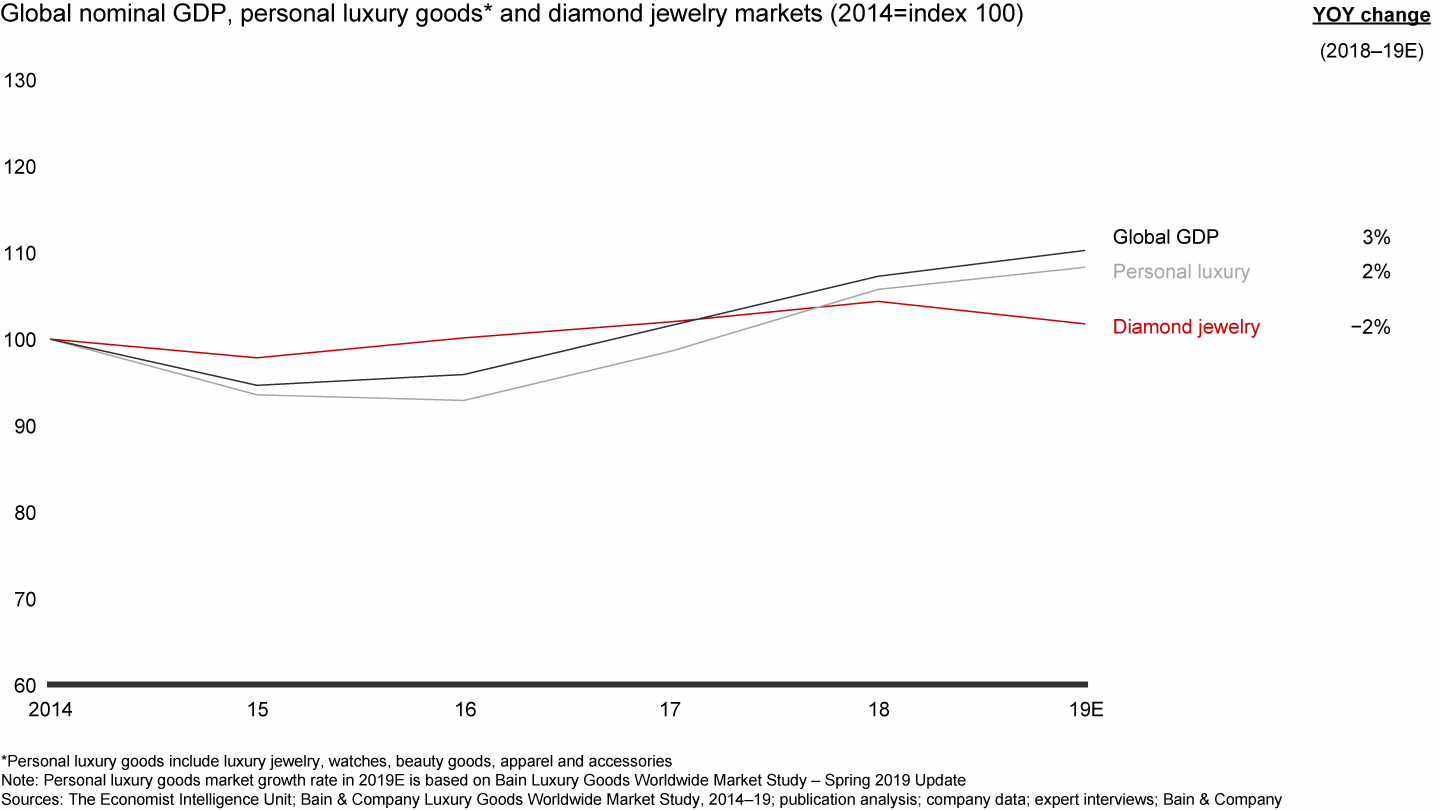
Global diamond jewelry sales grew in 2018 but are expected to decline in 2019

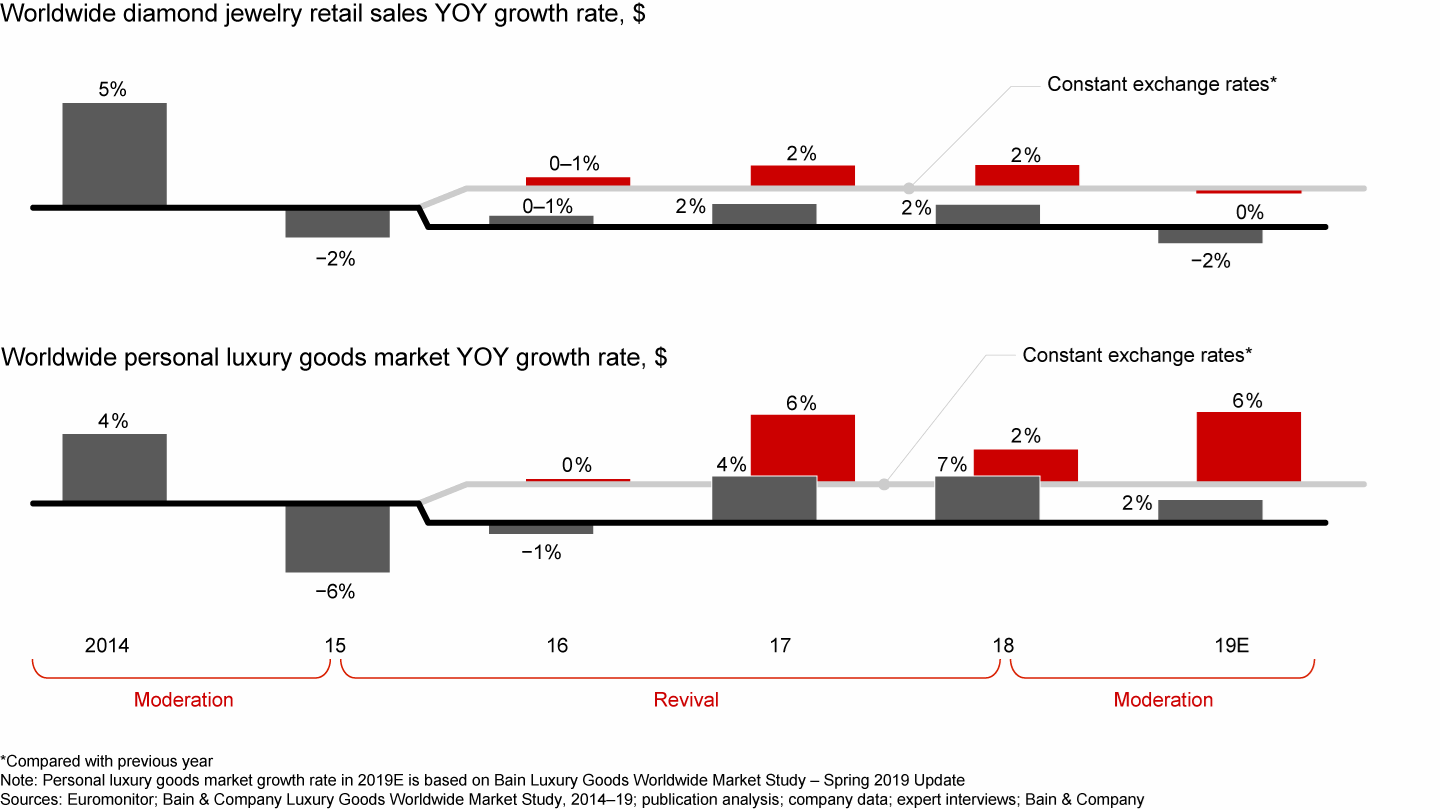
The US, China and India drove diamond jewelry sales growth over the past three years

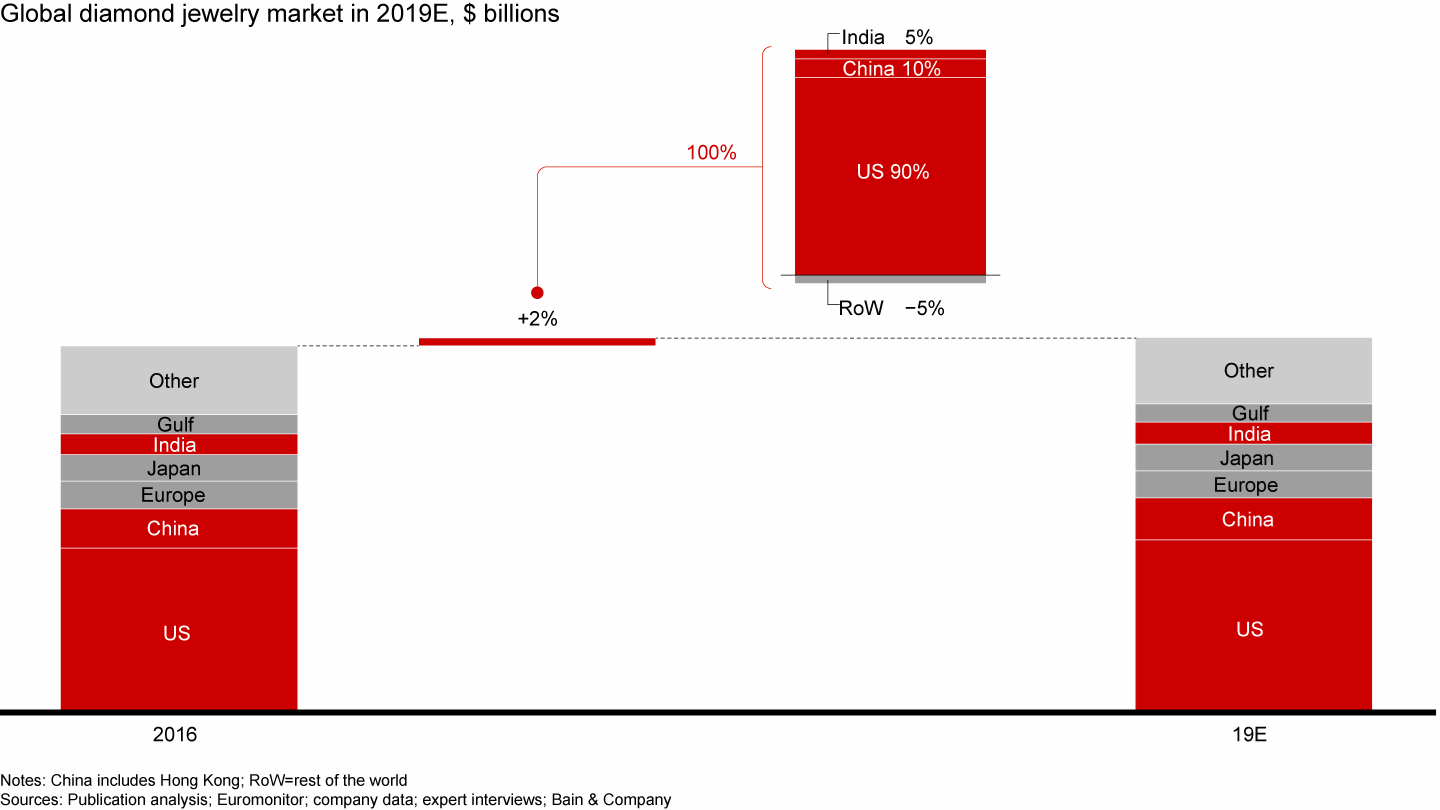
Diamond jewelry sales grew in most geographic markets in 2018; in 2019, growth is expected to continue in India and the Gulf

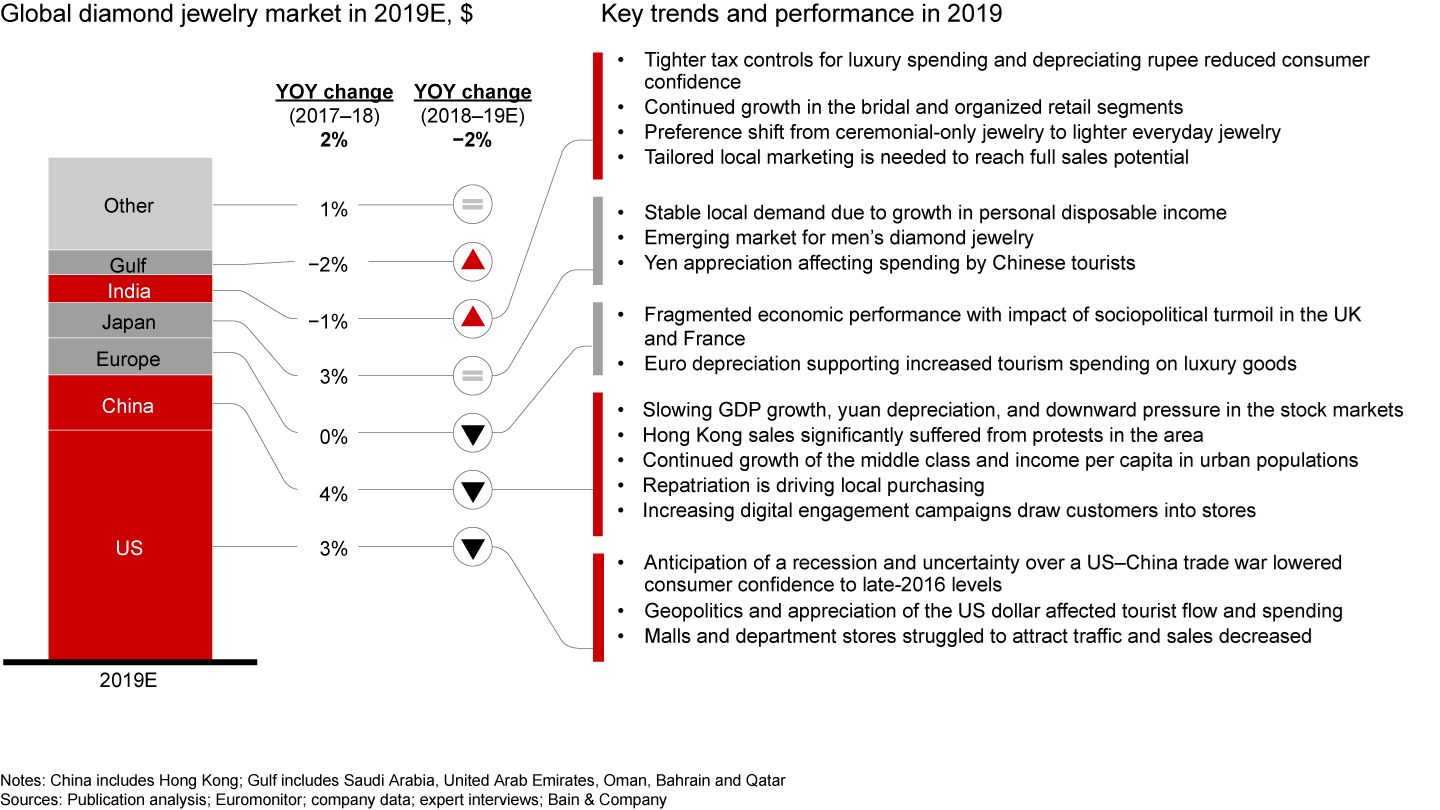
Fewer Chinese tourists and lower consumer confidence affected the US market

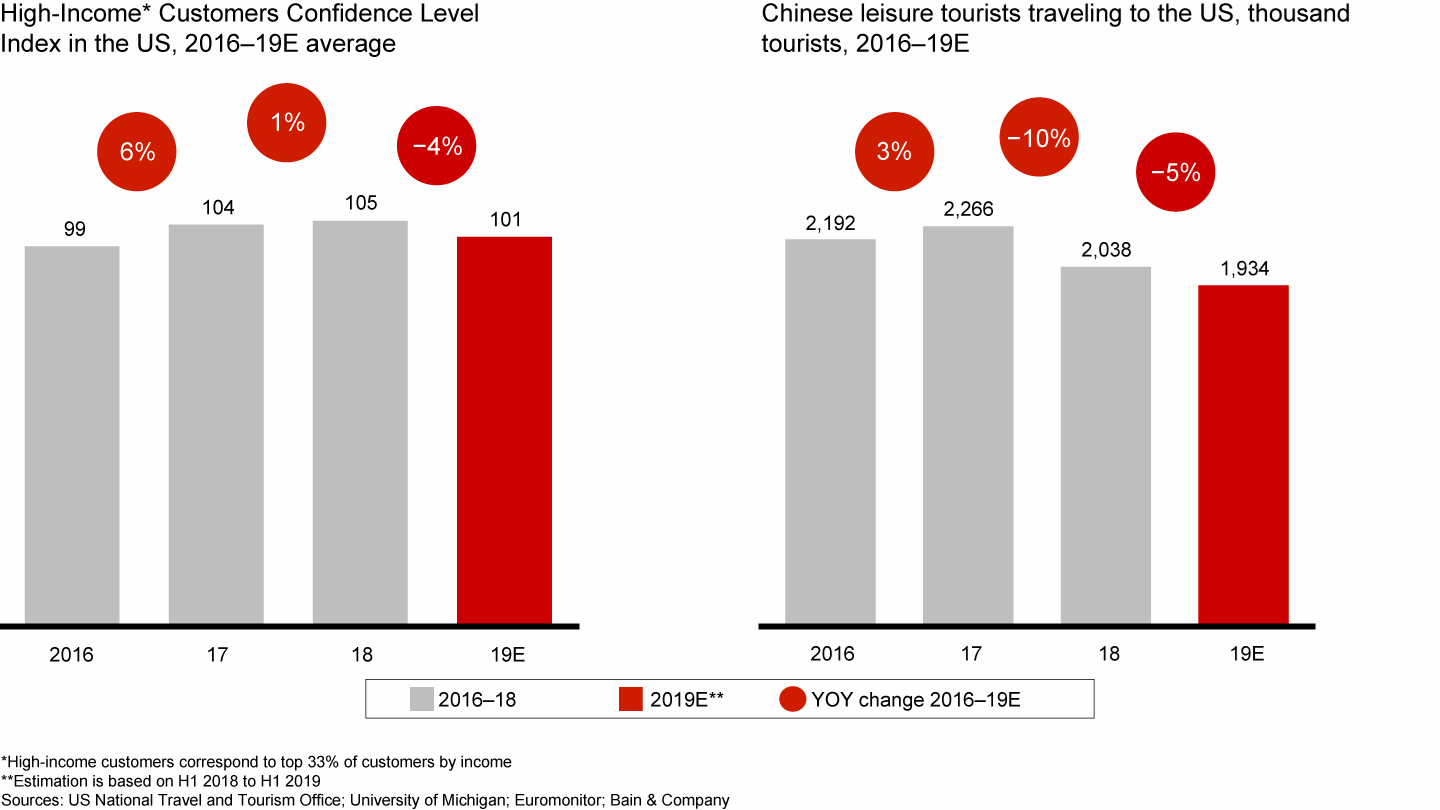
Appreciation of the US dollar in 2019 led to a decrease in retail sales at current exchange rates

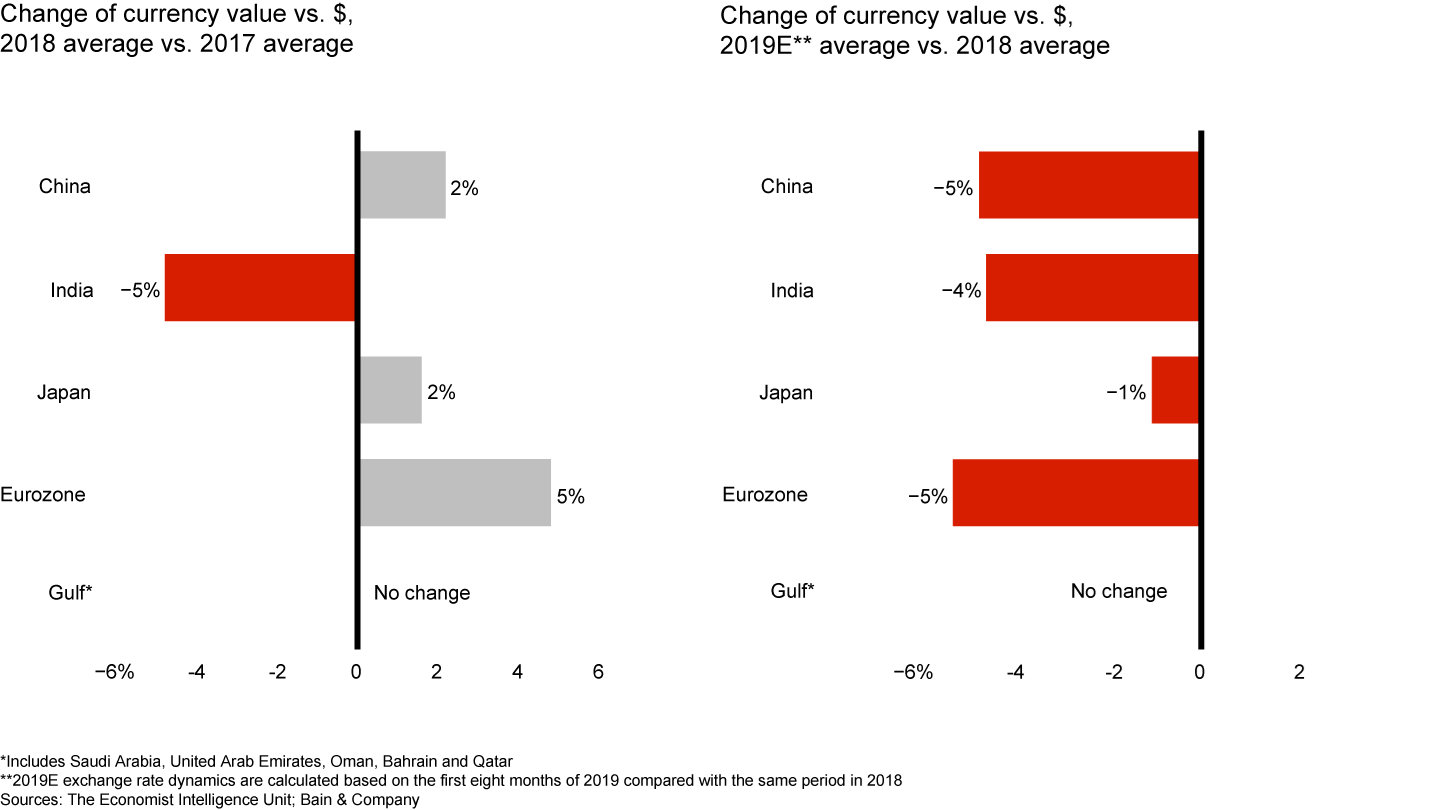
5. Key industry trends
- Four trends have the highest potential to impact the industry in the near term: rapid growth of online sales channels, increased marketing spending to support the natural diamond industry, developments in lab-grown diamonds, and an increased focus on the environment and sustainability.
- At just 5% to 10%, the share of online diamond jewelry sales lags behind other consumer products. However, e-commerce is accelerating, and major diamond jewelry retailers in the US and China increased their online sales to 13% and 11%, respectively. Greater pricing transparency and retail stock optimization caused by e-commerce will significantly affect demand and pricing for polished diamonds.
- Mining companies increased their marketing efforts, both brand-focused and generic, and raised marketing budgets to historically high levels. In 2019, more than $200 million was invested in diamond industry marketing, including $70 million to $80 million of generic marketing channeled through the Diamond Producers Association. The industry is using marketing to combat complex challenges, such as rapidly changing customer preferences, increased competition from the Experiences and Electronics categories, and the rapidly growing lab-grown diamond market.
- In 2018 and 2019, production of lab-grown diamonds increased 15% to 20%, with majority of the growth coming from China. As the lab-grown market evolves, several business models are emerging. Chinese companies primarily use high-pressure, high-temperature (HPHT) technologies to produce rough diamonds, competing on lowest production cost. In the US, companies are pursuing a vertically integrated business model by selling premium branded jewelry. If we assume that early growth in the lab-grown market happened because both wholesale and retail prices were decreasing differentially, allowing players to earn better margins than with natural stones, then wholesale prices have stabilized. We expect additional pressure on retail prices to accelerate lab-grown diamond jewelry sales.
- Both consumers and investors are demanding more transparent and environmentally responsible practices. Multiple industry initiatives are focused on pipeline transparency and traceability, which could increase the confidence of both lenders and consumers. Midstream operations may become more transparent and more efficiently managed as a result.
Online diamond jewelry sales trail other consumer goods categories but are growing in major markets

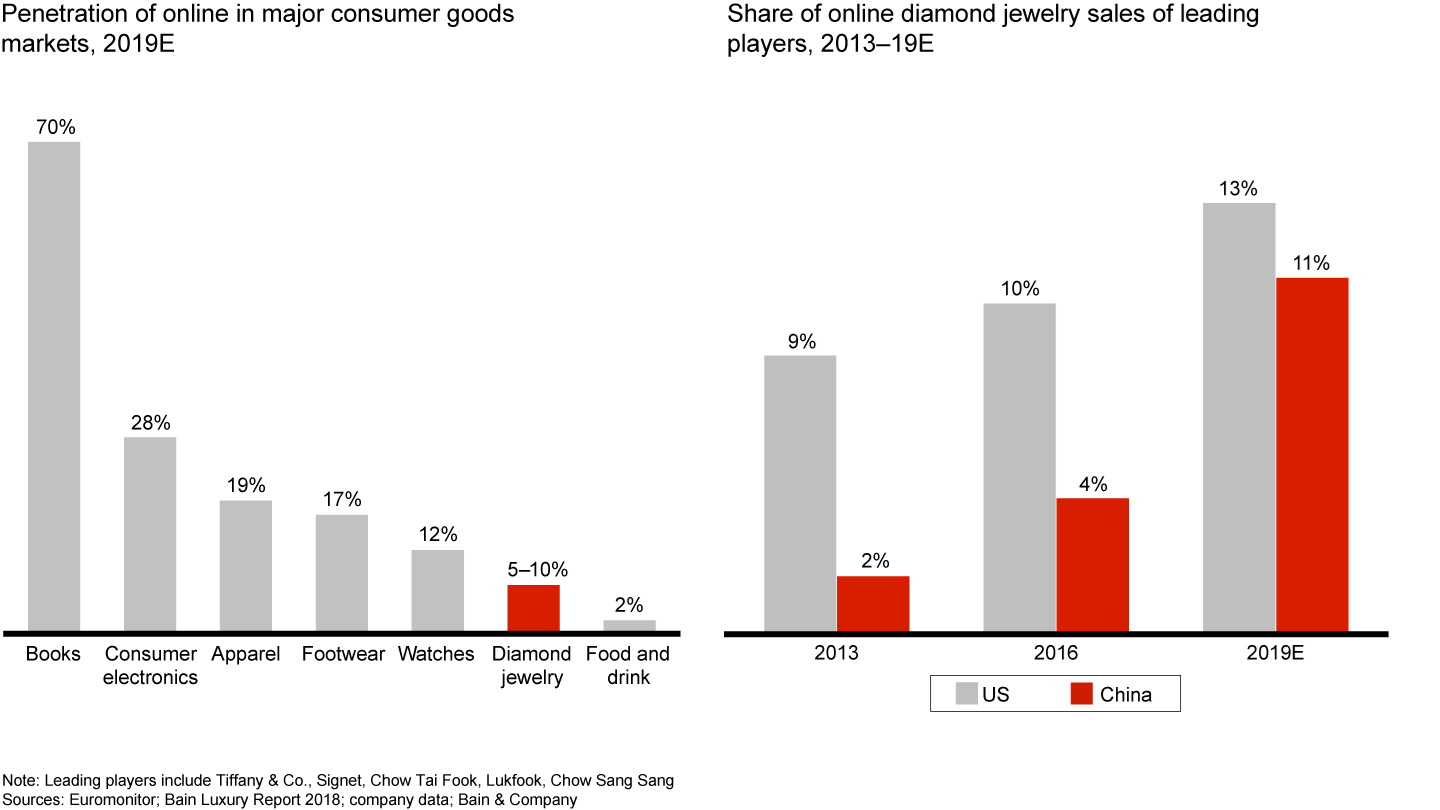
e-Commerce presents opportunities to optimize inventory and increase sales

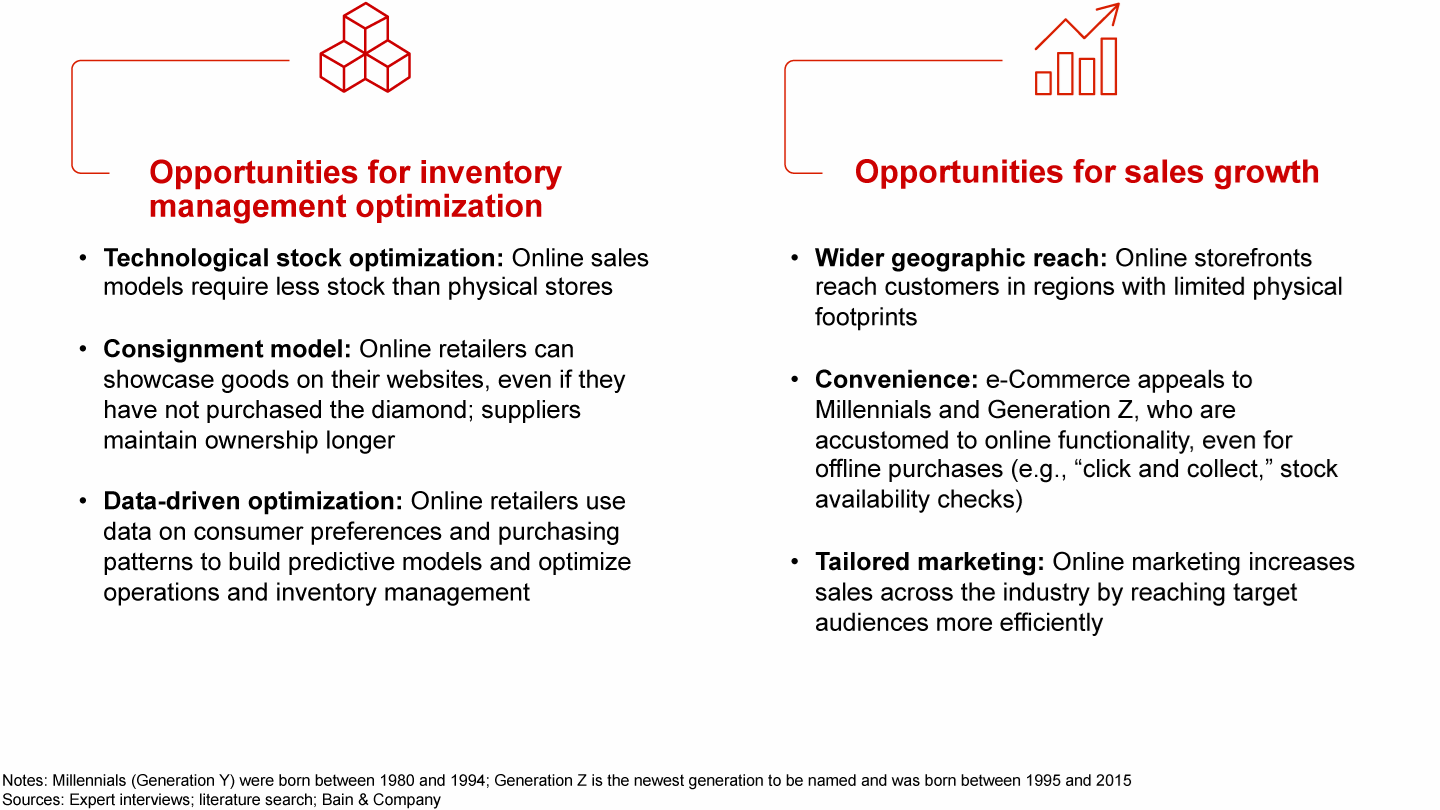
Marketing spending returned to near-record levels, but challenges loom

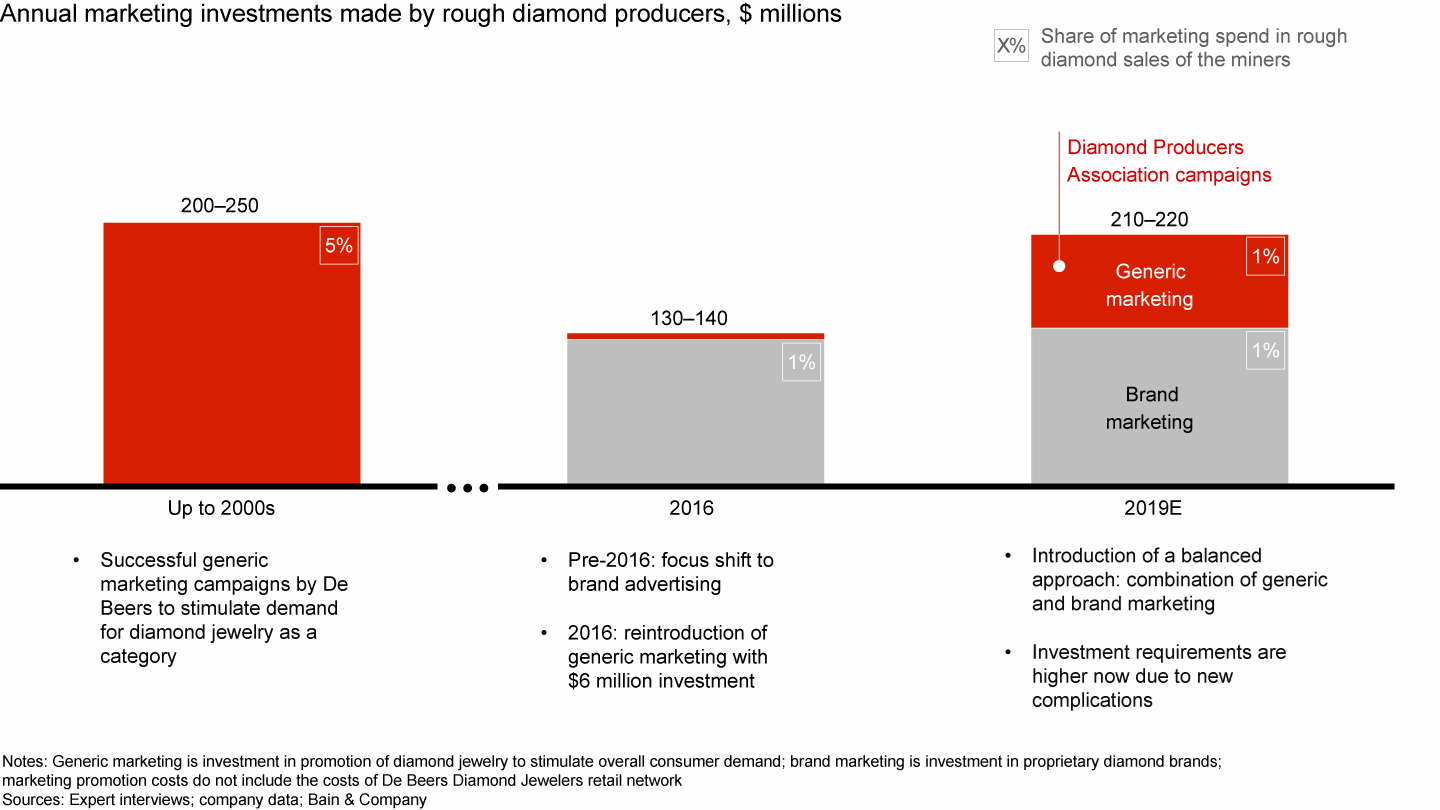
Recent marketing campaigns differed by country

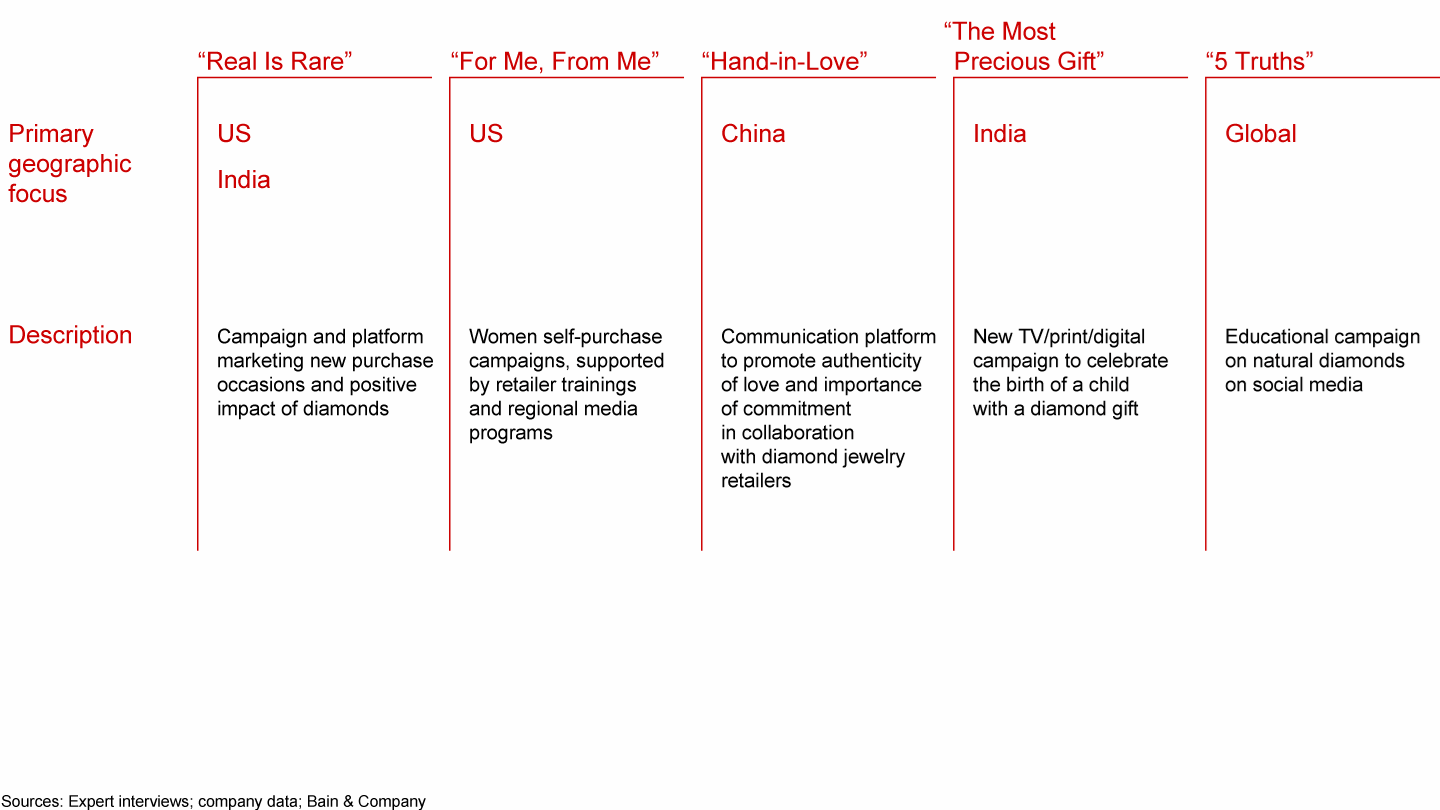
Most lab-grown diamonds are purchased in the US but produced in China, India and the US

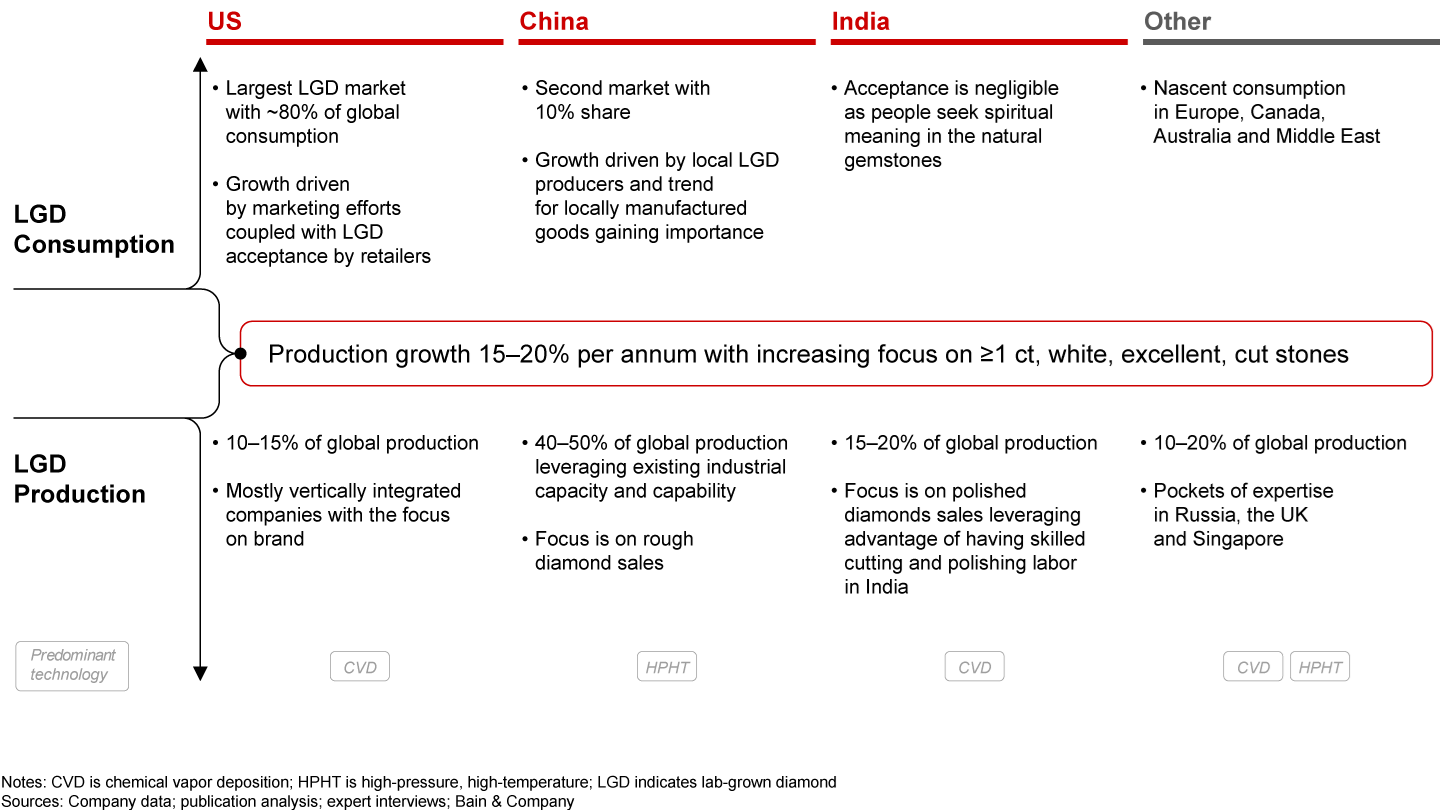
Both retail and wholesale price discounts for lab-grown diamonds have stabilized

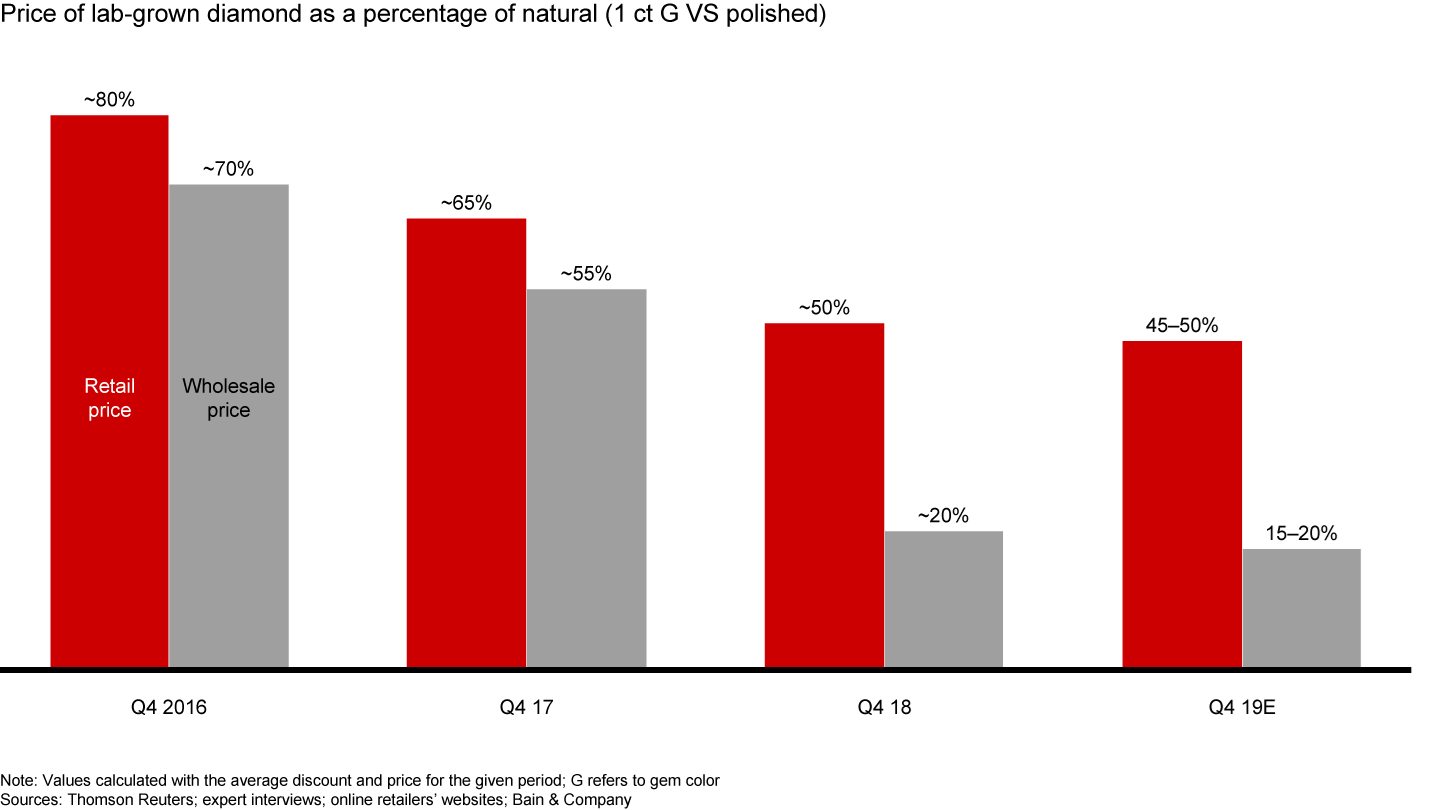
Sustainability requirements are evolving, prompting industry response

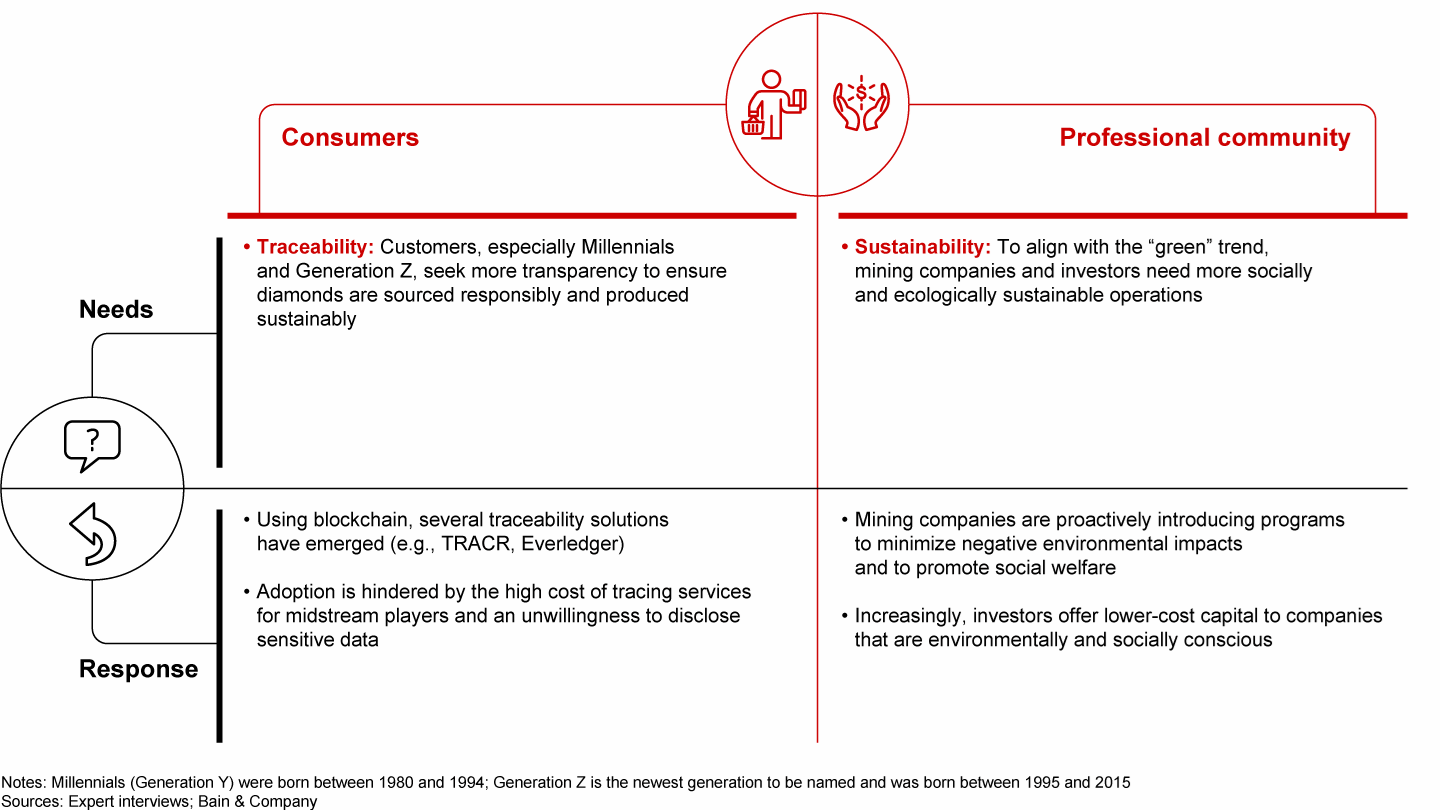
Diamond producers are improving their environmental and social performance

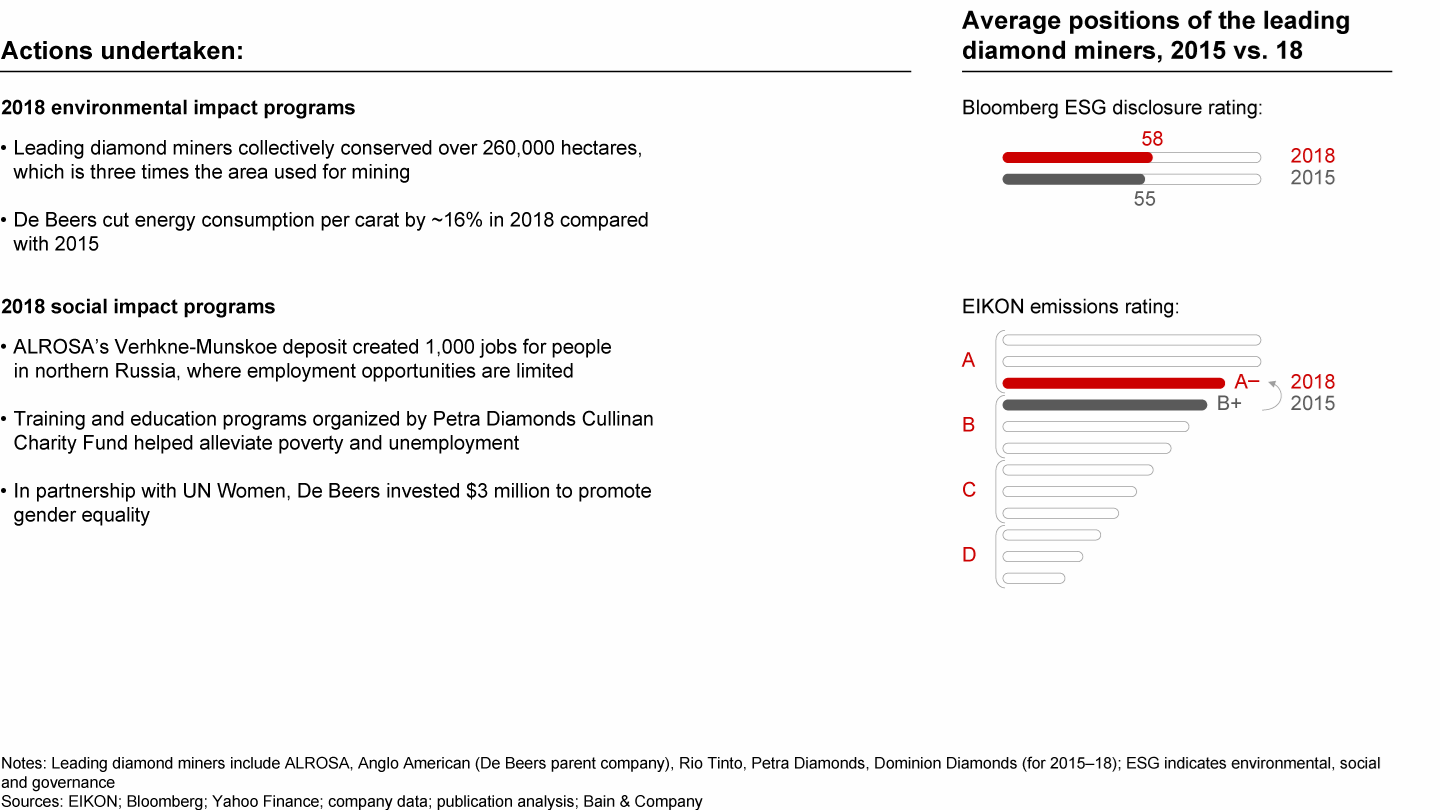
6. Historical analysis of industry recessions and implications
- Over the past 50 years, the diamond market has grown three times. Historically, nominal pricing adjustments for rough and polished diamonds were 4% and 3%, respectively. There has generally been a strong correlation between rough and polished prices, aside from some short-term deviations that can be explained by supply and demand issues.
- The relationship between supply and demand is well illustrated throughout the industry’s recessions and recoveries. Since 1970, the industry has experienced four major downturns: global recessions disrupted the industry in the late 1970s and early 1980s and again in 2008–09. In 1985 and 2015, downturns were caused by inefficiencies in the diamond pipeline.
- Downturns caused by global macroeconomic recessions typically experienced 6 to 12 months of price decline followed by one or two years to reach full price recovery. Upstream players historically adjusted their supply of rough diamonds to support price recovery, and this helped midstream players and retailers destock until demand returned. In 2009, for example, mining companies decreased rough diamond sales by 50%.
- In comparison, downturns caused by internal pipeline inefficiencies took longer to recover. In 1985, the introduction of Argyle increased supply by 7 million carats. It took three years for stock to fully work through the system and for prices to return to historic levels. In 2015, slower demand for diamond jewelry and retail footprint rationalization in China were followed by a 20% jump in production in 2017. Those factors led to stock accumulation throughout the pipeline, the effects of which are still felt today.
- We expect 2020 to be better for the industry once the midstream starts to clear its excess inventory in the beginning of the year. However, ongoing supply–demand inequality will prevent full recovery of the industry and may be exacerbated by a continuing decrease in available financing for midstream players. Few producers have announced sufficient mining plan cuts, so we do not foresee a major decline in supply. Retail sales will not grow significantly because consumer confidence and spending are diminishing in anticipation of a global recession. There is also no short-term expectation of an increase in available financing.
- The industry’s first and strongest opportunity to rebalance and regain growth will be 2021. Rough diamond supply is projected to decrease about 8%, and macroeconomic indicators are expected to improve if the global recession is short-lived.
Short-term volatility and a few long-term factors are causing the recent industry trends

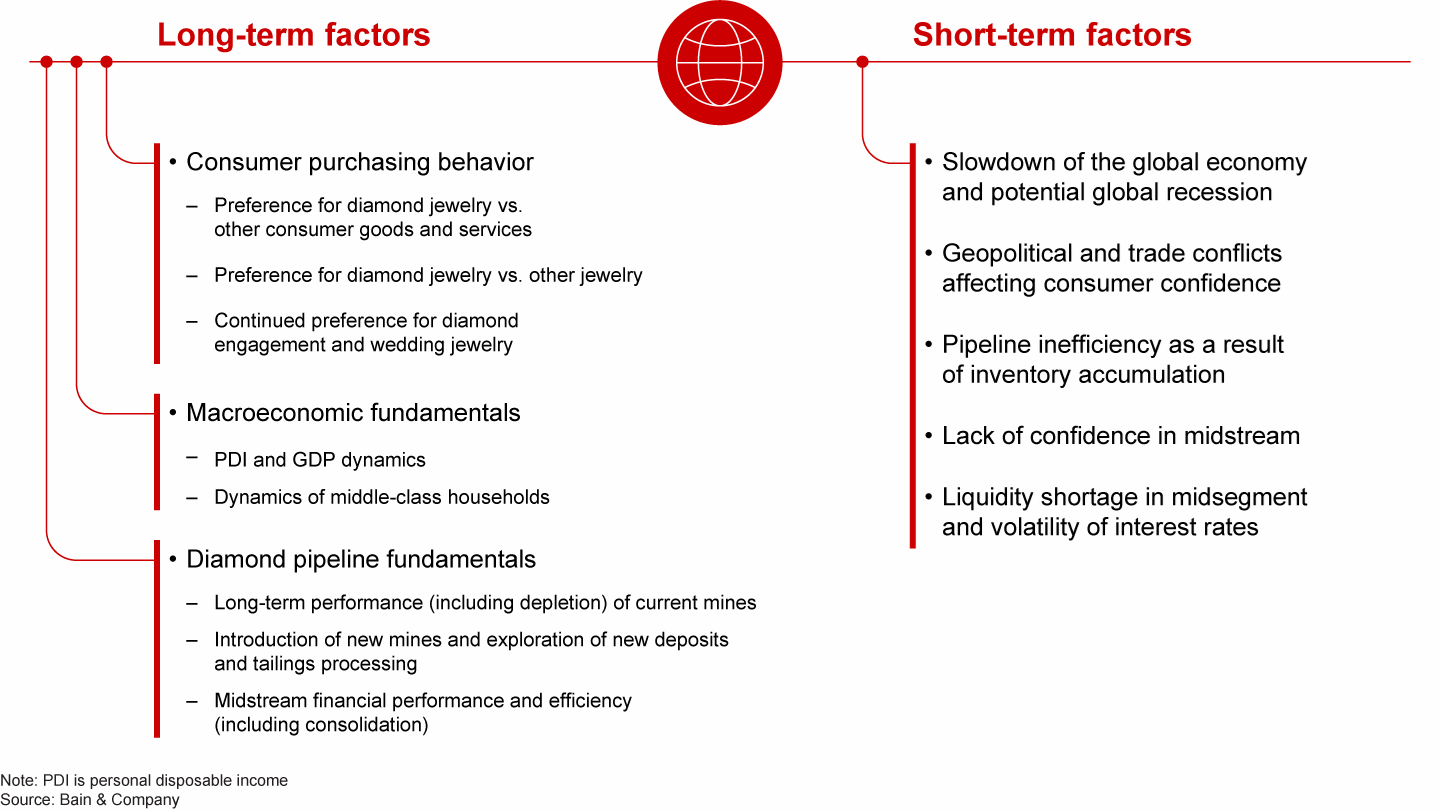
Before 2019, the industry experienced only four recessions in the past 50 years

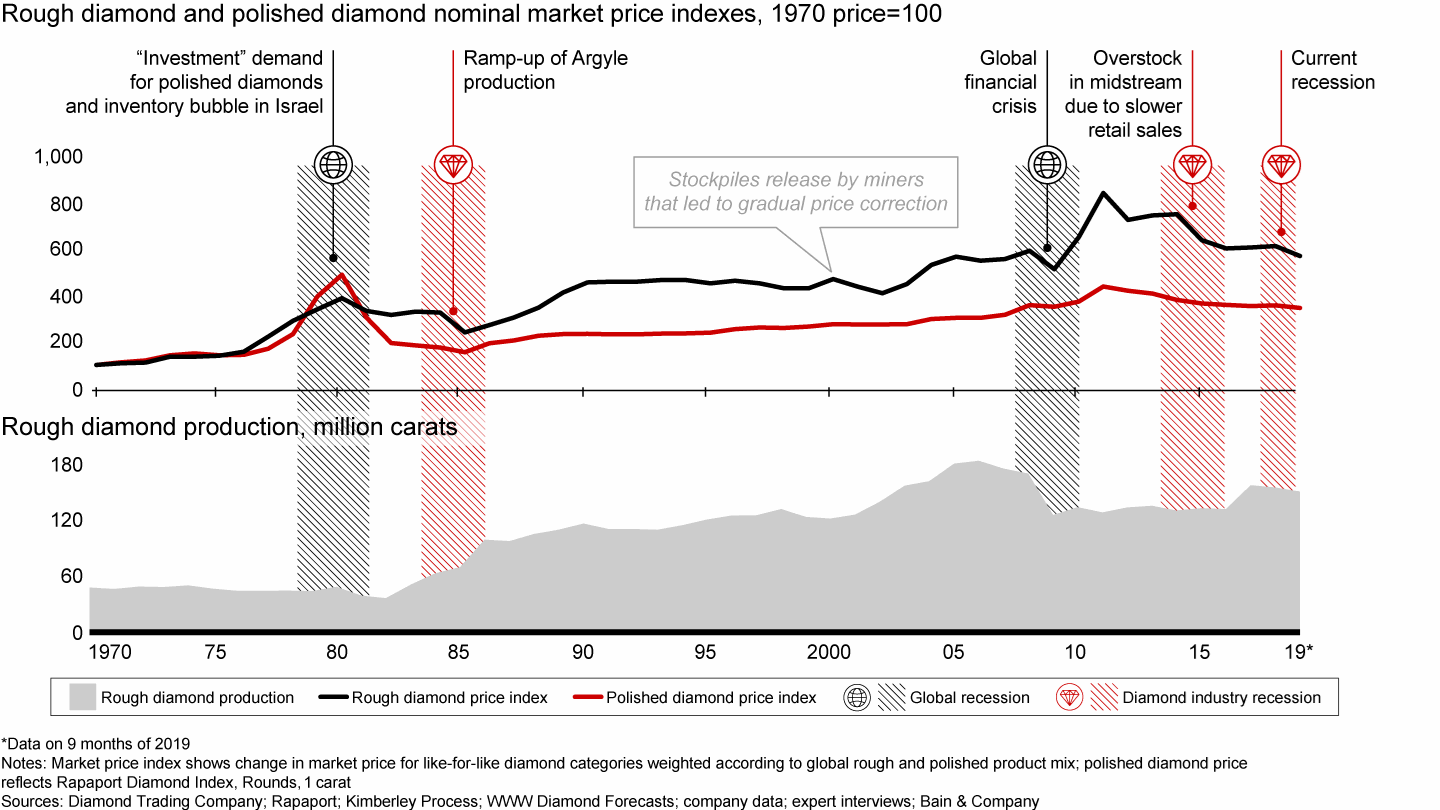
Since 1970, the industry has experienced healthy long-term price growth for rough and polished diamonds

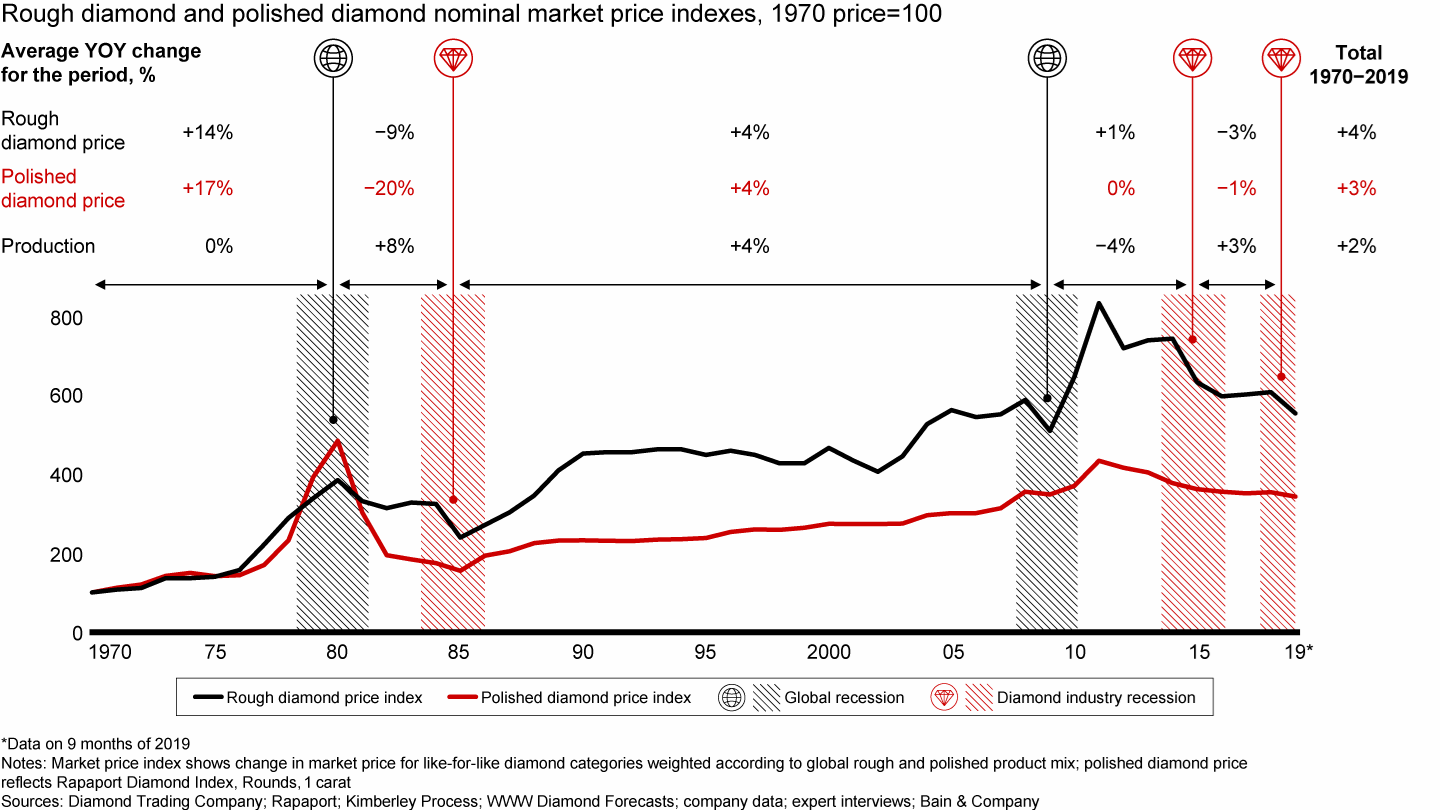
Recessions caused by internal dynamics took longer to recover than downturns caused by global economics

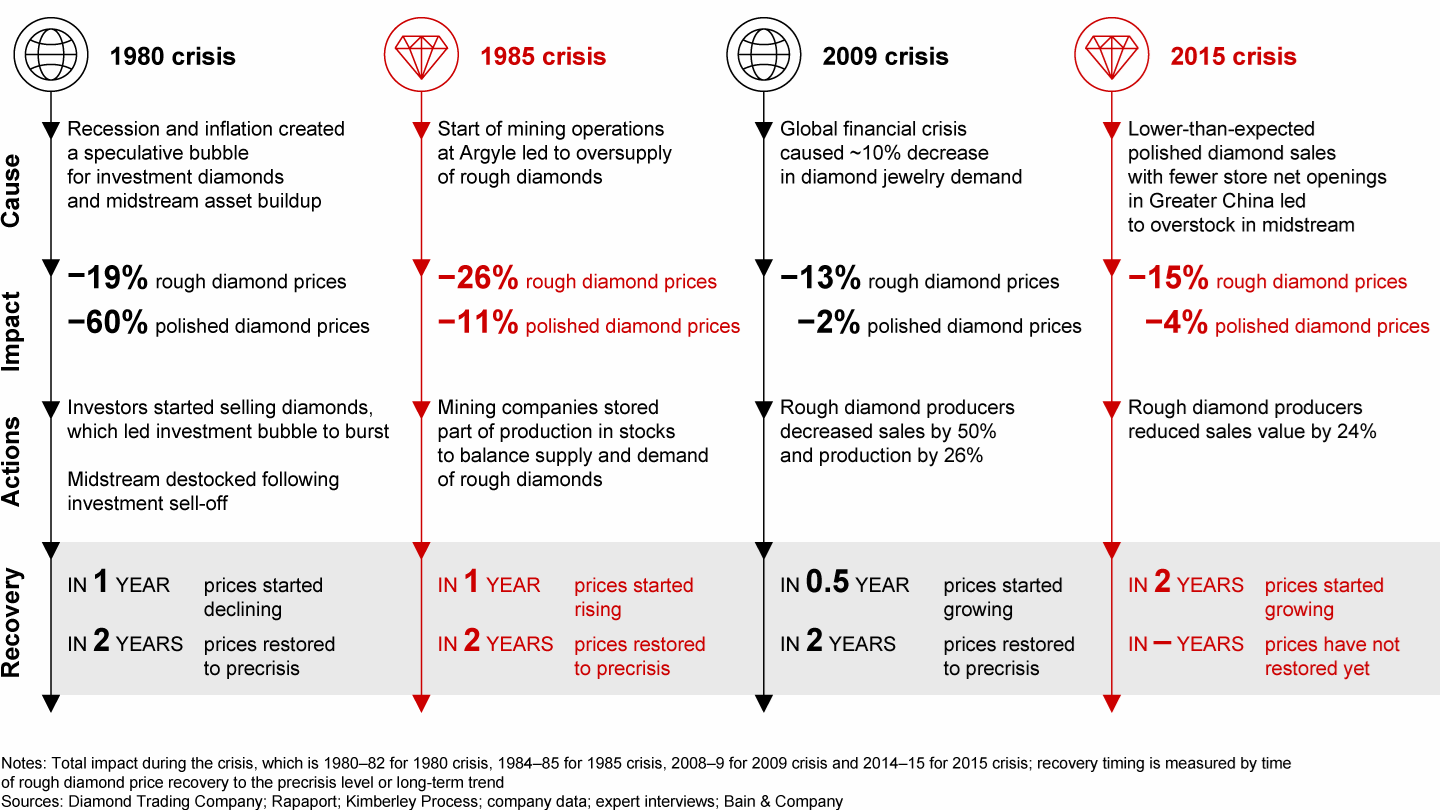
Perspective on the current downturn

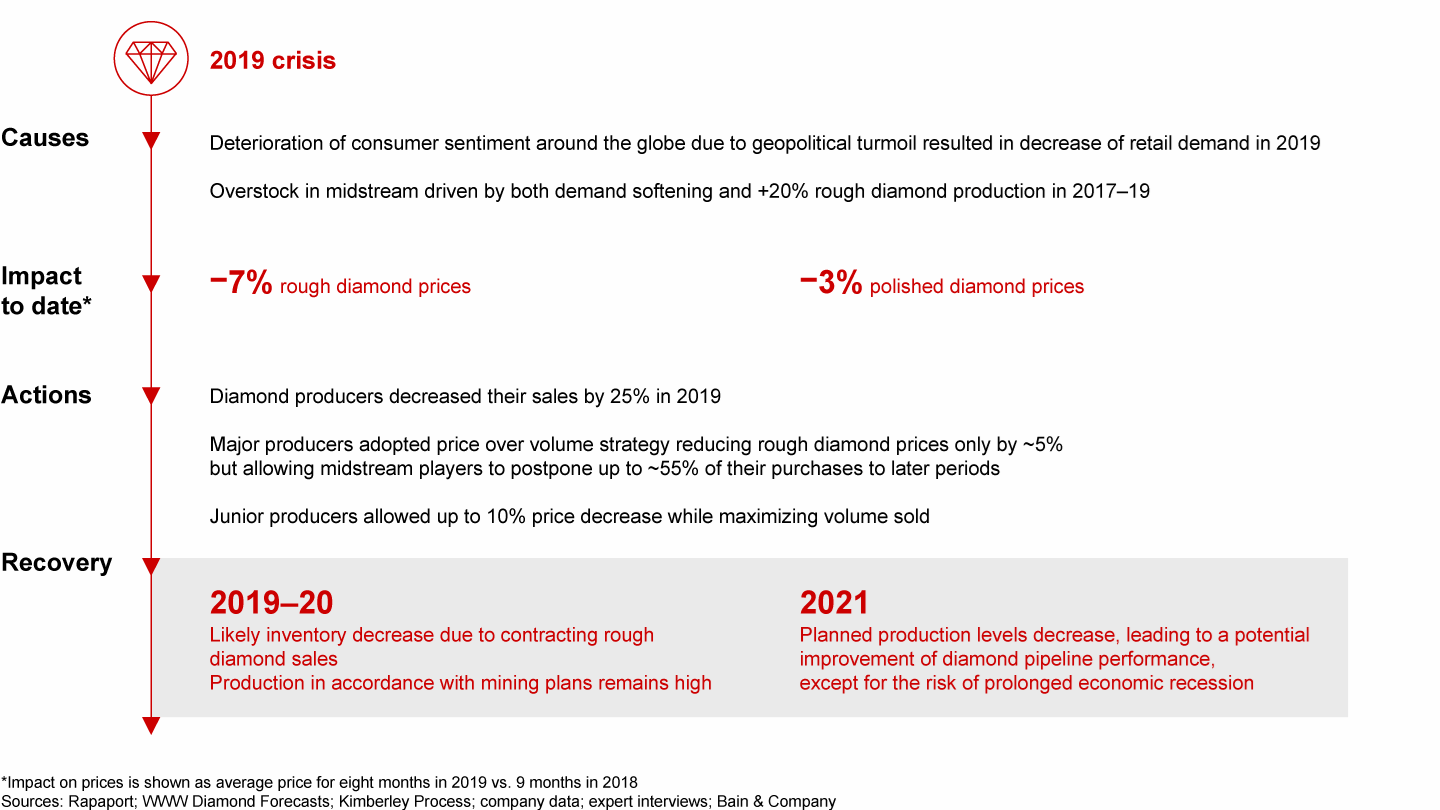
7. Updated supply and demand model
- Global rough diamond supply is projected to decrease 8% to 15% by 2021 compared with 2019. The dip will be followed by stable production through 2030. If mining companies are confident in long-term price growth, they will invest in new projects to maintain production levels around 140 million carats. If confidence is lacking, supply may decrease annually by 1% to 2%, settling at around 110 million carats. If fundamental factors such as GDP and middle-class growth are strong, and if marketing efforts create sufficient emotional appeal for diamond jewelry, then demand is expected to grow at an average annual rate of up to 3%. Our outlook incorporates potential shifts in consumer preferences and reflects fundamental supply and demand factors rather than short-term fluctuations.
- The global economy is projected to grow at an annual rate of 3% through 2030. The US, China and India will continue to lead growth in diamond jewelry consumption. Following a relatively brief recession in the next one to two years, we expect the US to grow around 2% annually in the long term. The middle class will expand in China and India by 4% and 9%, respectively, and personal income will increase for Millennials and Generation Z. In combination, these factors provide a strong foundation for growth. Growth rates may be slower over the next few years if a global economic slowdown occurs, but long-term diamond jewelry consumption should be unaffected.
- Based on lessons learned from natural and synthetic sapphires, we expect lab-grown diamond substitution to stay within 5% to 15% in value terms through 2030. Lab-grown and natural sapphires have remained separate markets for more than 20 years, and synthetic sapphires account for 15% of the total gem-quality market in volume. Lab-grown diamond prices have been falling, which may lead to a sustainable business in costume jewelry. As mines deplete, lab-grown diamonds could offset a portion of the reduction in supply of natural diamonds.
- This forecast does not consider several factors that could disrupt the supply–demand balance in the short term and slow the overall global trajectory. Consumer confidence and demand for diamond jewelry could be negatively affected if the US recession is longer than expected or if the slowdown and uncertainty in China caused by trade tension continue. Ongoing currency fluctuations and short-term policy changes in India could disrupt that country’s potential, as they have in the past. The biggest potential disruption is consumer preference. Continued and concerted marketing efforts are imperative to sustain long-term demand.
Supply is expected to decrease 8–15% by 2021, followed by stable production into 2030

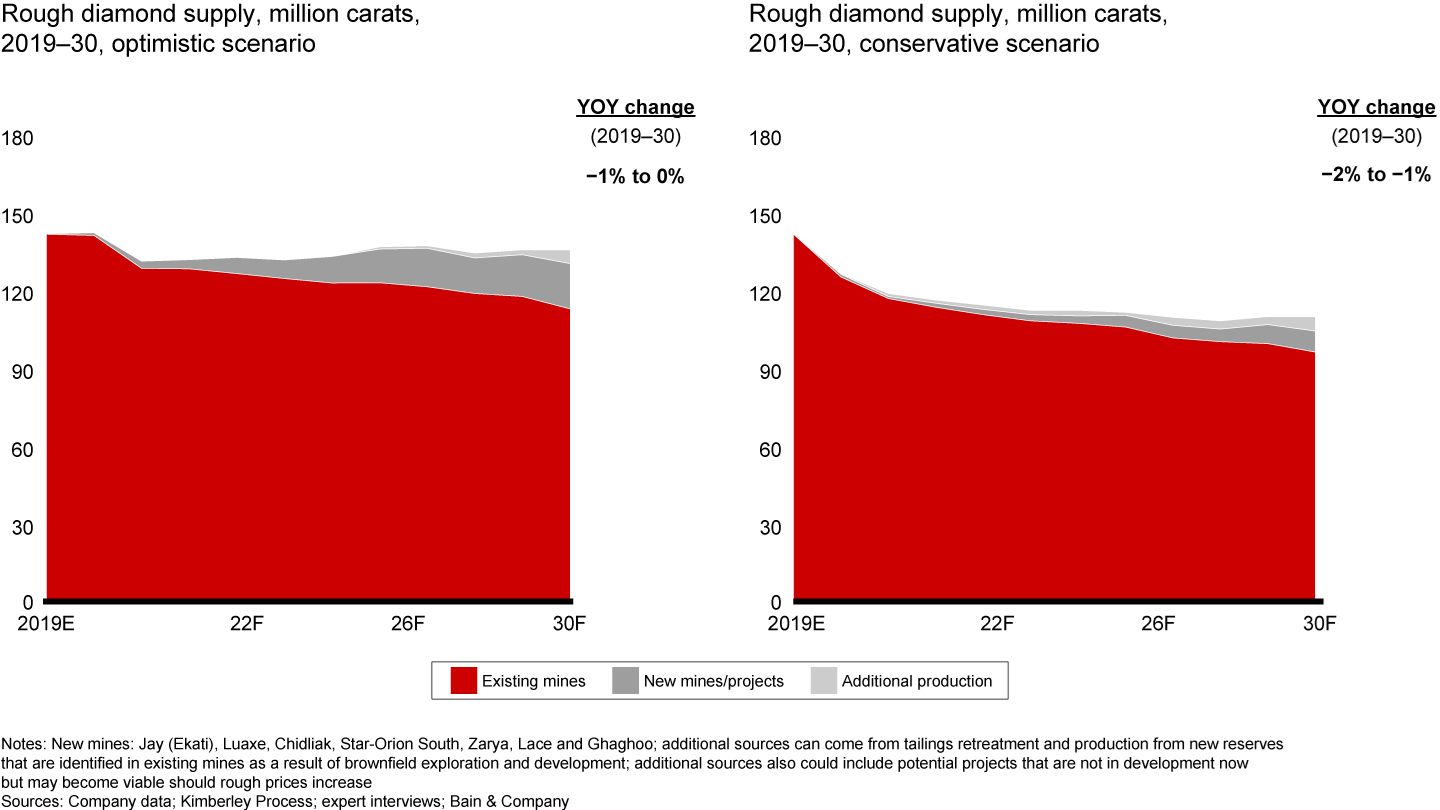
Although a near-term recession is expected, the long-term macroeconomic forecast is positive

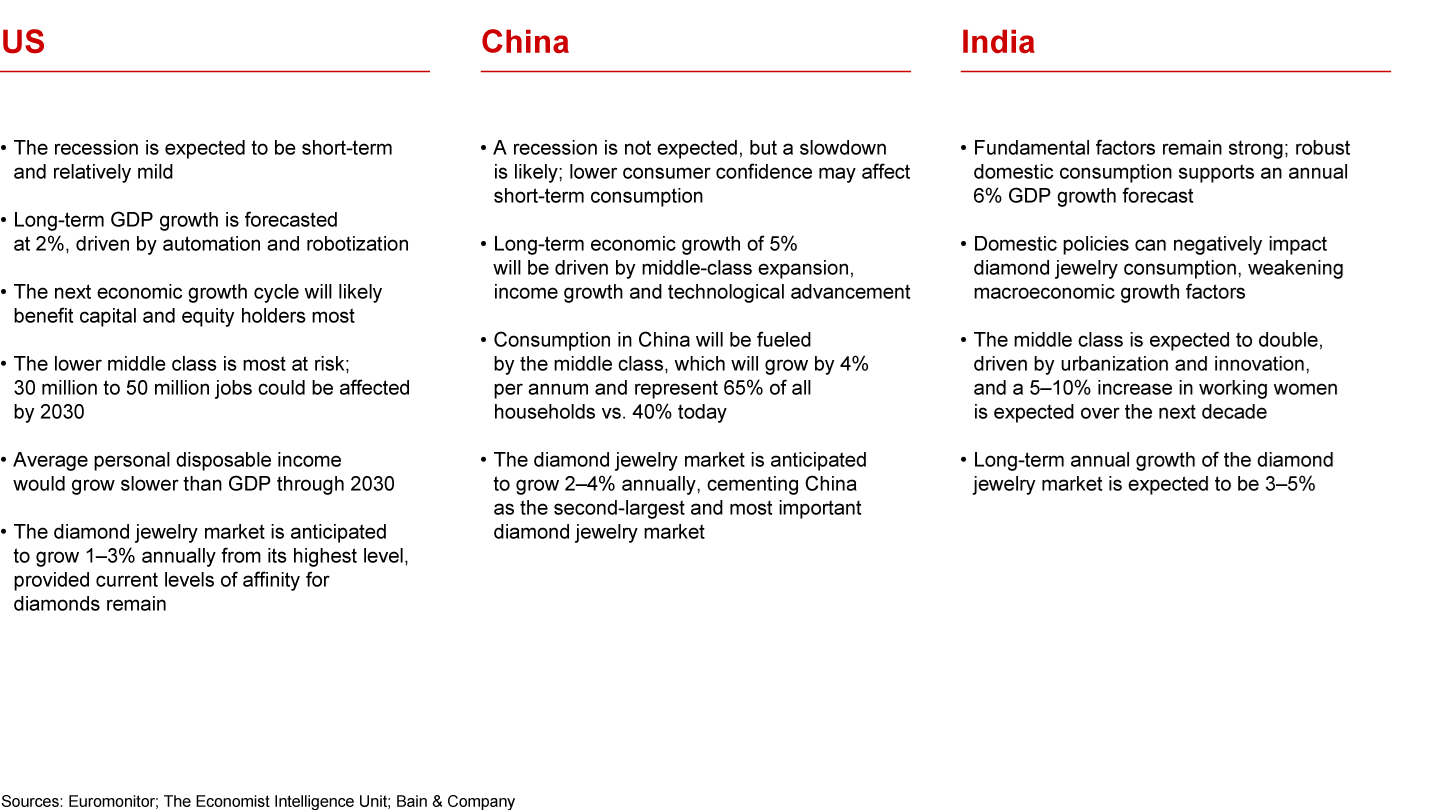
The long-term outlook for real global GDP and PDI remains healthy, notwithstanding a potential short-term recession

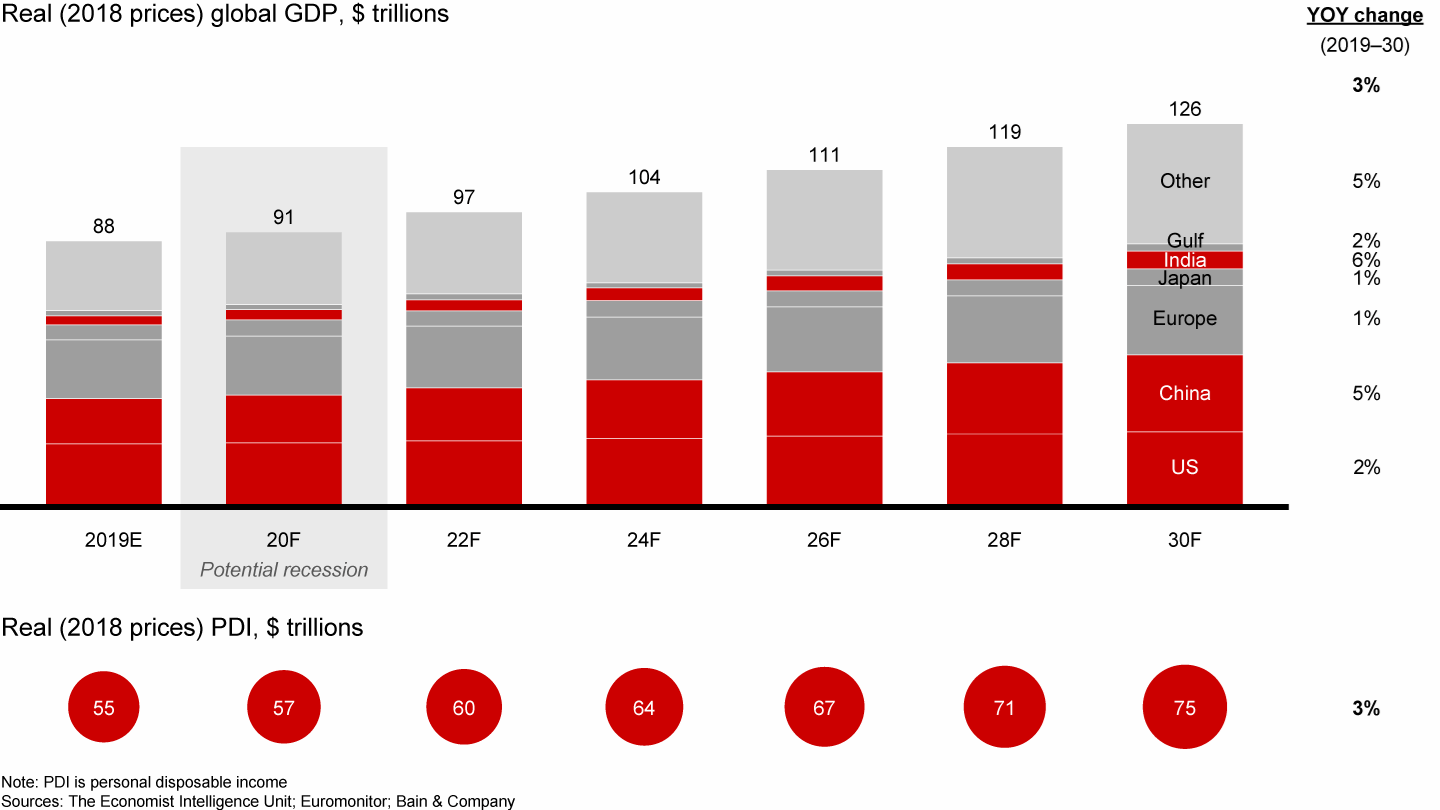
Growth of China’s and India’s middle class will reinforce positive long-term demand

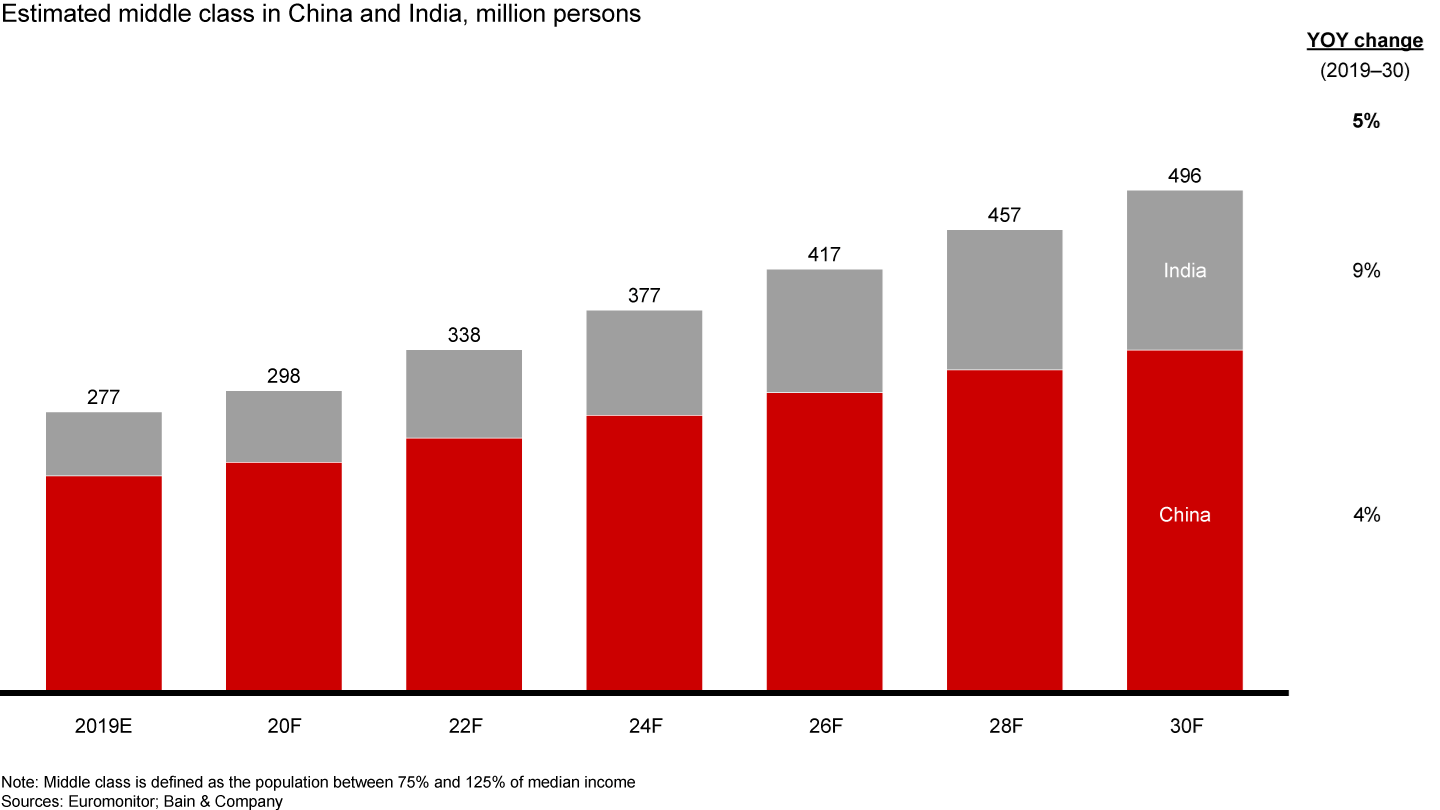
In the US, China and India, the combined real gross income of Millennials and Generation Z will double by 2030

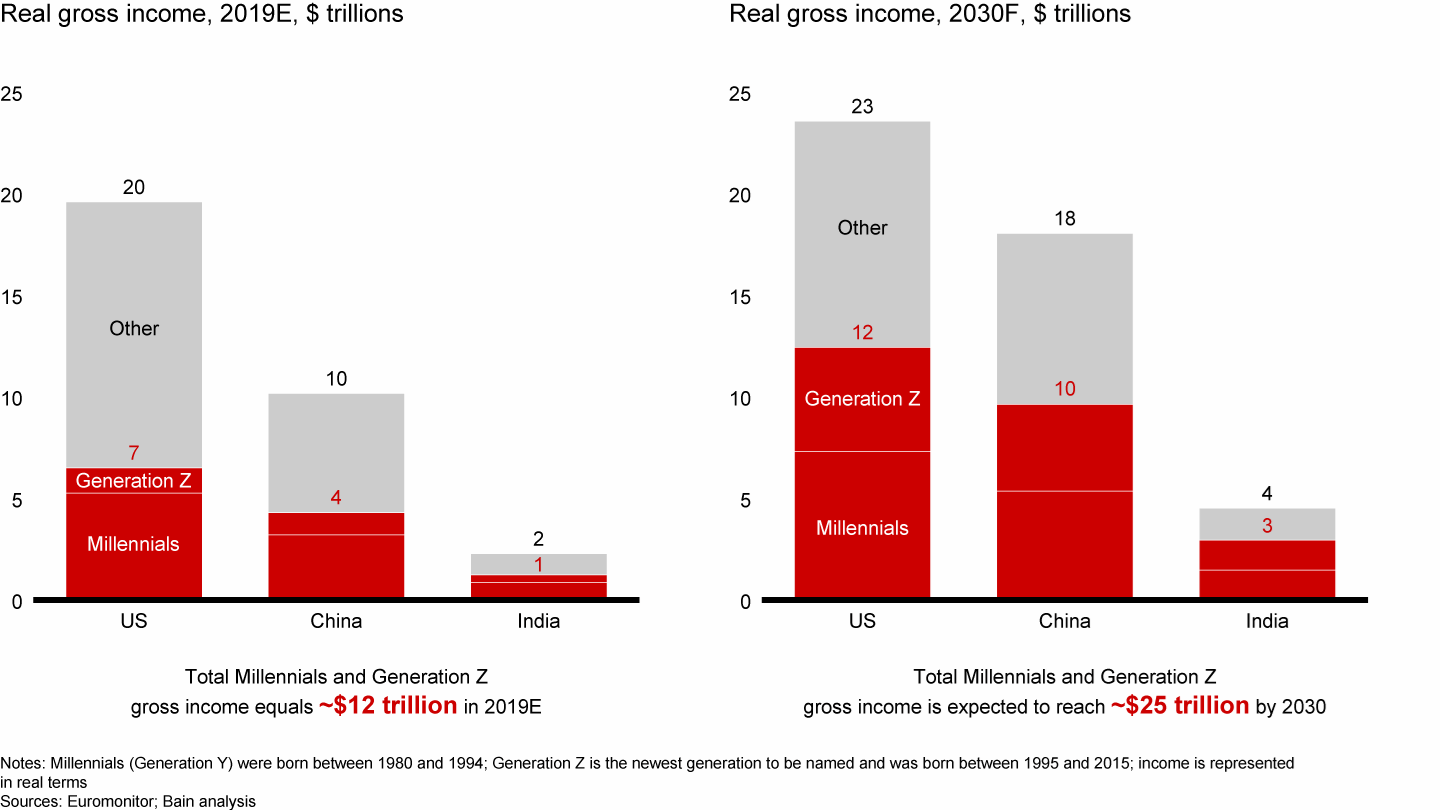
Synthetic sapphires account for 15% of the sapphire jewelry market

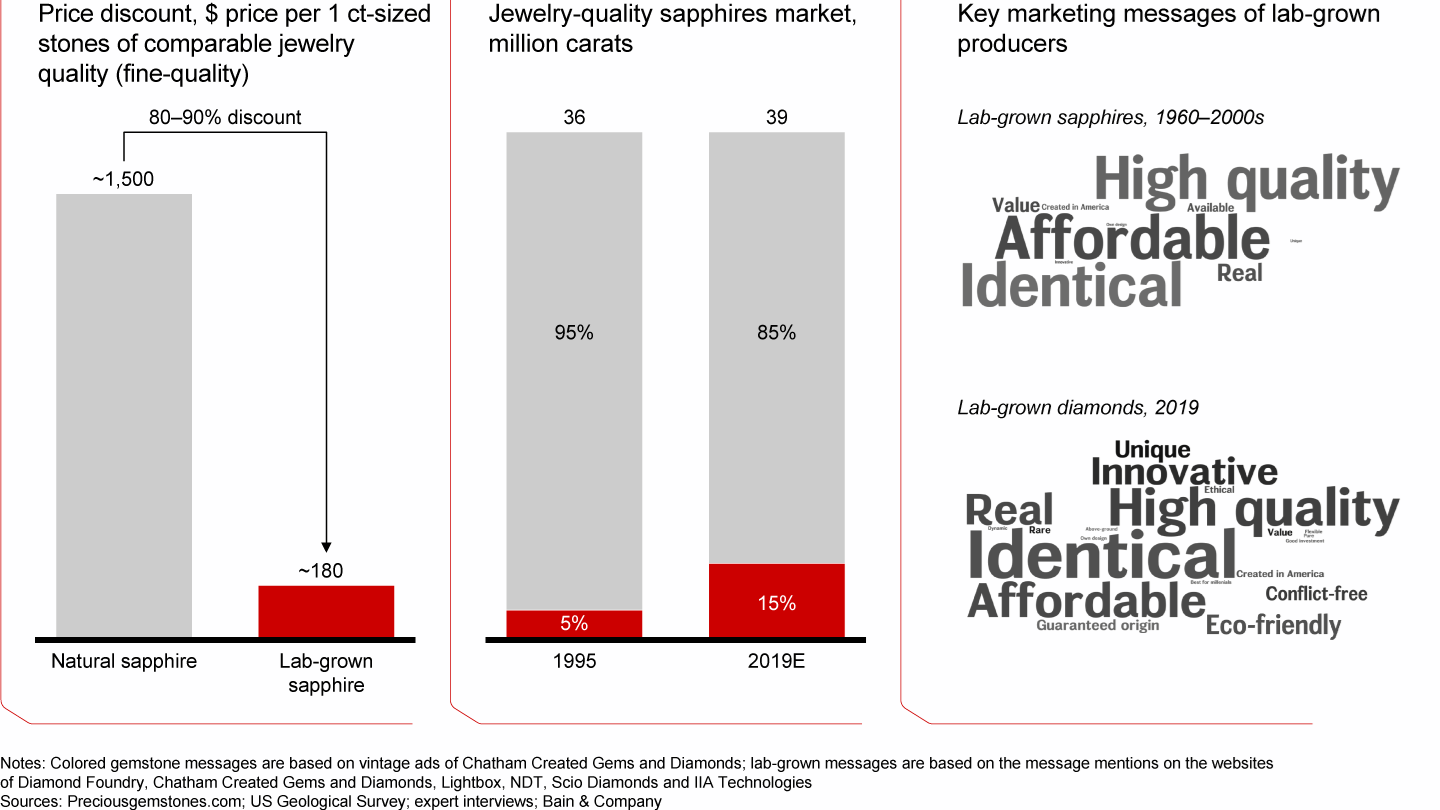
Key assumptions behind long-term scenarios for natural rough diamond demand

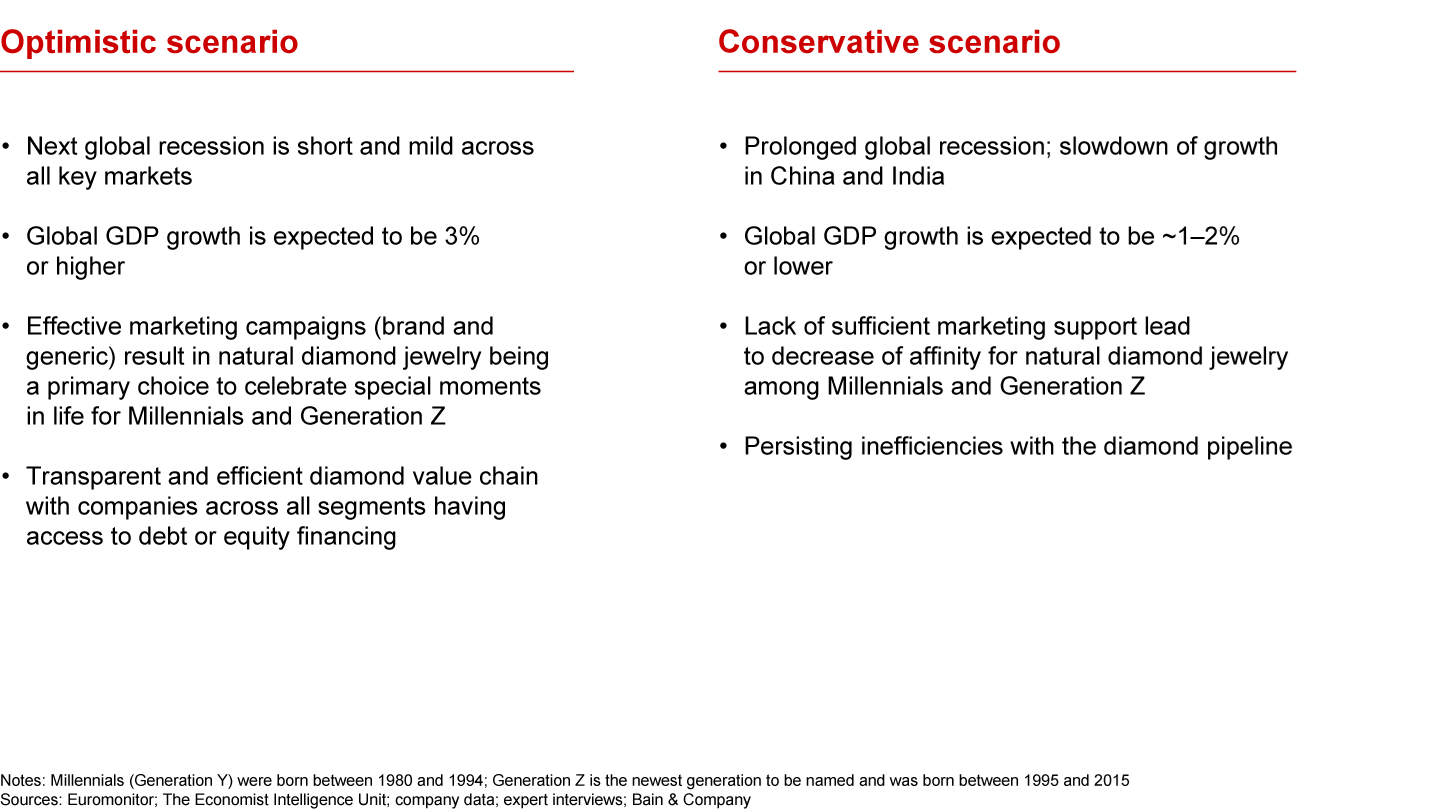
The supply–demand outlook is moderately optimistic

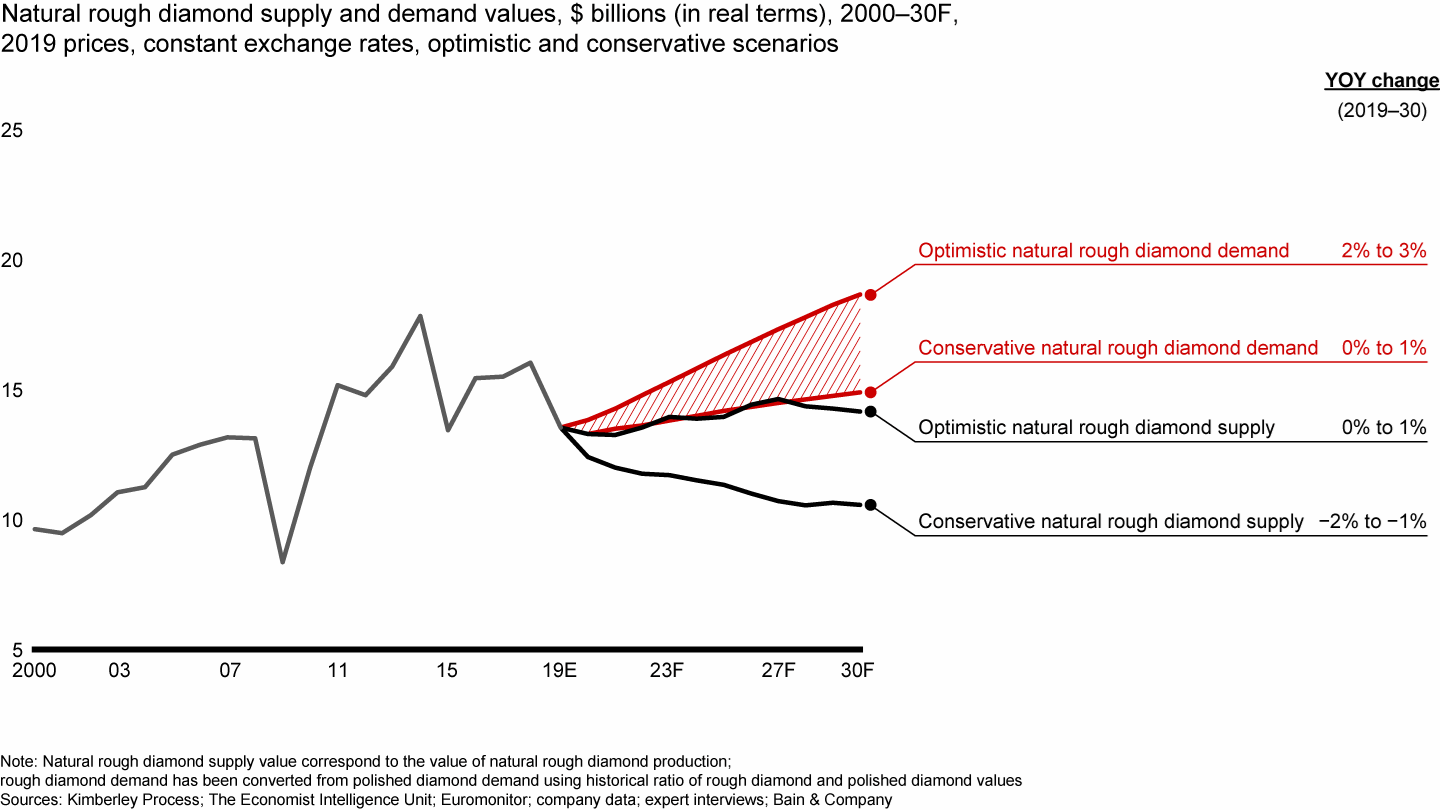
About this report
This work was commissioned by AWDC and prepared by Olya Linde, a partner with Bain & Company, and Ari Epstein, chief executive officer, AWDC. It is based on secondary market research, analysis of financial information available or provided to Bain & Company and AWDC, and a range of interviews with customers, competitors and industry experts. Bain & Company and AWDC have not independently verified this information and make no representation or warranty, express or implied, that such information is accurate or complete. Projected market and financial information, analyses and conclusions contained herein are based (unless sourced otherwise) on the information described above and on Bain & Company’s and AWDC’s judgment, and should not be construed as definitive forecasts or guarantees of future performance or results. Neither Bain & Company nor AWDC nor any of their subsidiaries or their respective officers, directors, shareholders, employees or agents accept any responsibility or liability with respect to this document. This document is copyright of Bain & Company, Inc. and AWDC and may not be published, copied or duplicated, in whole or in part, without the written permission of Bain & Company and AWDC.